Casio WK-3800, WK8000, WK-3300 User Manual
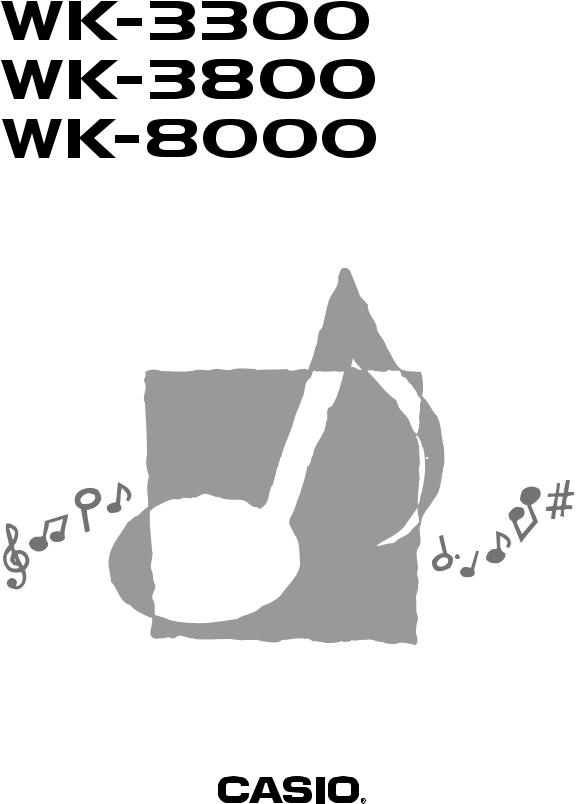
E
USER’S GUIDE
WK3300/8000E1A
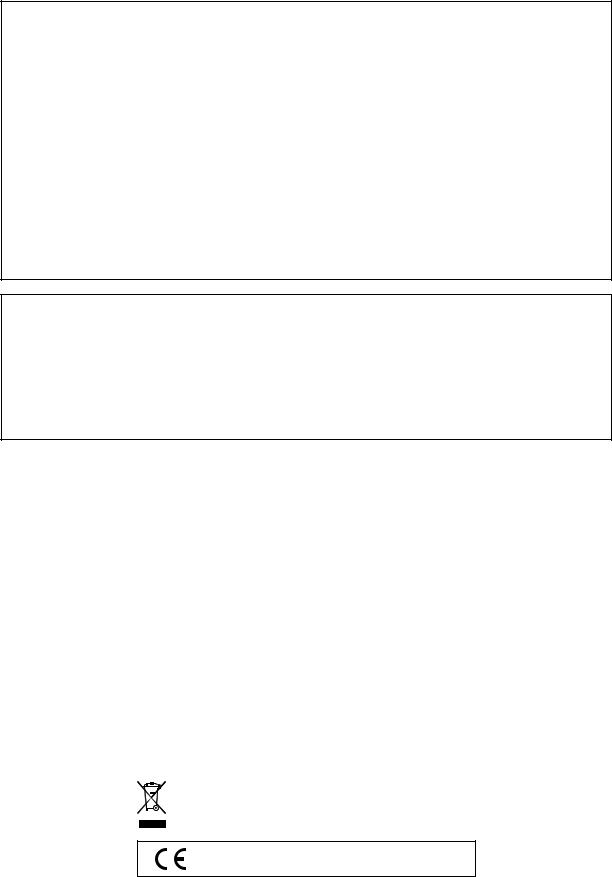
GUIDELINES LAID DOWN BY FCC RULES FOR USE OF THE UNIT IN THE U.S.A. (not applicable to other areas).
NOTICE
This equipment has been tested and found to comply with the limits for a Class B digital device, pursuant to Part 15 of the FCC Rules. These limits are designed to provide reasonable protection against harmful interference in a residential installation. This equipment generates, uses and can radiate radio frequency energy and, if not installed and used in accordance with the instructions, may cause harmful interference to radio communications. However, there is no guarantee that interference will not occur in a particular installation. If this equipment does cause harmful interference to radio or television reception, which can be determined by turning the equipment off and on, the user is encouraged to try to correct the interference by one or more of the following measures:
•Reorient or relocate the receiving antenna.
•Increase the separation between the equipment and receiver.
•Connect the equipment into an outlet on a circuit different from that to which the receiver is connected.
•Consult the dealer or an experienced radio/TV technician for help.
FCC WARNING
Changes or modifications not expressly approved by the party responsible for compliance could void the user’s authority to operate the equipment.
Declaration of Conformity
Model Number: WK-3300/WK-3800/WK-8000
Trade Name: CASIO COMPUTER CO., LTD. Responsible party: CASIO, INC.
Address: 570 MT. PLEASANT AVENUE, DOVER, NEW JERSEY 07801
Telephone number: 973-361-5400
This device complies with Part 15 of the FCC Rules, Operation is subject to the following two conditions:
(1) This device may not cause harmful interference, and (2) this device must accept any interference received, including interference that may cause undesired operation.
Important!
Please note the following important information before using this product.
•Before using the optional AD-12 Adaptor to power the unit, be sure to check the AC Adaptor for any damage first. Carefully check the power cord for breakage, cuts, exposed wire and other serious damage. Never let children use an AC adaptor that is seriously damaged.
•Never attempt to recharge batteries.
•Do not use rechargeable batteries.
•Never mix old batteries with new ones.
•Use recommended batteries or equivalent types.
•Always make sure that positive (+) and negative (–) poles are facing correctly as indicated near the battery compartment.
•Replace batteries as soon as possible after any sign they are getting weak.
•Do not short-circuit the battery terminals.
•The product is not intended for children under 3 years.
•Use only CASIO AD-12 adaptor.
•The AC adaptor is not a toy.
•Be sure to disconnect the AC adaptor before cleaning the product.
This mark applies in EU countries only.
CASIO Europe GmbH
Bornbarch 10, 22848 Norderstedt, Germany
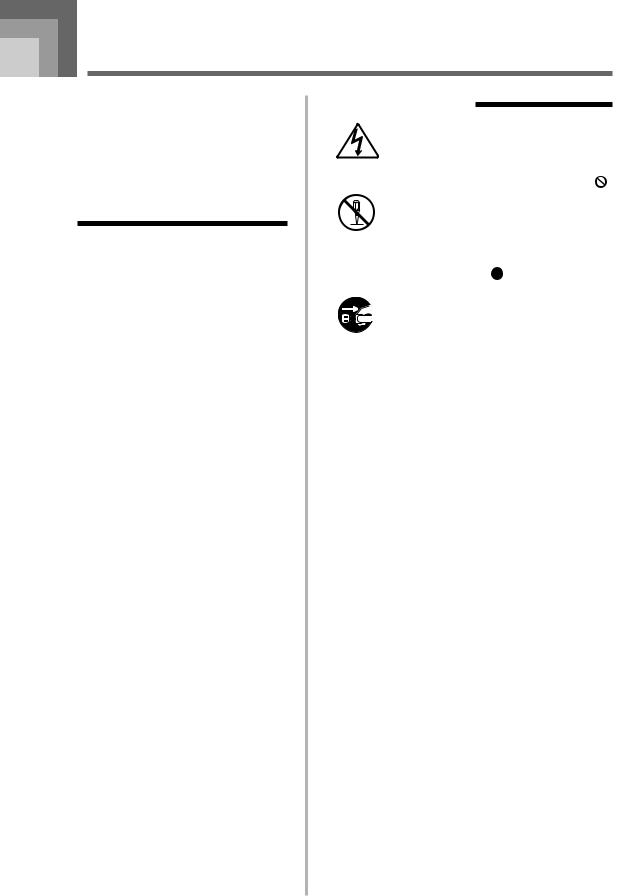
Safety Precautions
Congratulations on your selection of the CASIO electronic musical instrument.
•Before using the instrument, be sure to carefully read through the instructions contained in this manual.
•Be sure to keep all user documentation handy for future reference.
Symbols
Various symbols are used in this user’s guide and on the product itself to ensure that the product is used safely and correctly, and to prevent injury to the user and other persons as well as damage to property. Those symbols along with their meanings are shown below.
 DANGER
DANGER
This symbol indicates information that, if ignored or applied incorrectly, creates the danger of death or serious personal injury.
 WARNING
WARNING
This indication stipulates matters that have the risk of causing death or serious injury if the product is operated incorrectly while ignoring this indication.
 CAUTION
CAUTION
This indication stipulates matters that have the risk of causing injury as well as matters for which there is the likelihood of occurrence of physical damage only if the product is operated incorrectly while ignoring this indication.
Symbol Examples
This triangle symbol ( ) means that the user should be careful. (The example at left indicates electrical shock caution.)
) means that the user should be careful. (The example at left indicates electrical shock caution.)
This circle with a line through it ( ) means that the indicated action must not be performed. Indications within or nearby this symbol are specifically prohibited. (The example at left indicates that disassembly is prohibited.)
The black dot ( ) means that the indicated action must be performed. Indications within this symbol are actions that are specifically instructed to be performed. (The example at left indicates that the power plug must be unplugged from the electrical socket.)
) means that the indicated action must be performed. Indications within this symbol are actions that are specifically instructed to be performed. (The example at left indicates that the power plug must be unplugged from the electrical socket.)
E-1

Safety Precautions

 DANGER
DANGER
Alkaline Batteries
Perform the following steps immediately if fluid leaking from alkaline batteries ever gets into your eyes.
1.Do not rub your eyes! Rinse them with water.
2.Contact your physician immediately. Leaving alkaline battery fluid in your eyes can lead to loss of sight.

 WARNING
WARNING
Smoke, Strange Odor, Overheating
Continued use of the product while it is emitting smoke, a strange odor, or heat creates the risk of fire and electric shock. Take the following steps immediately.
1.Turn off power.
2.If you are using the AC adaptor for power, unplug it from the wall outlet.
3.Contact your original retailer or an authorized CASIO Service Provider.
AC Adaptor
●Misuse of the AC adaptor creates the risk of fire and electric shock. Always make sure you observe the following precautions.
•Be sure to use only the AC adaptor that is specified for this product.
•Use only a power source whose voltage is the within the rating marked on the AC adaptor.
•Do not overload electrical outlets and extension cords.
●Misuse of the AC adaptor’s electric cord can damage or break it, creating the risk of fire and electric shock. Always make sure you observe the following precautions.
•Never place heavy objects on the cord or subject it to heat.
•Never try to modify the cord or subject it to excessive bending.
•Never twist or stretch the cord.
•Should the electric cord or plug become damaged, contact your original retailer or authorized CASIO Service Provider.
E-2
●Never touch the AC adaptor while your hands are wet.
Doing so creates the risk of electric shock.
●Use the AC adaptor where it will not be splashed with water. Water creates the risk of fire and electric shock.
●Do not place a vase or any other container filled with liquid on top of the AC adaptor. Water creates the risk of fire and electric shock.
Batteries
Misuse of batteries can cause them to leak, resulting in damage to nearby objects, or to explode, creating the risk of fire and personal injury. Always make sure you observe the following precautions.
•Never try to take batteries apart or allow them to become shorted.
•Never expose batteries to heat or dispose of them by incineration.
•Never mix old batteries with new ones.
•Never mix batteries of different types.
•Do not charge the batteries.
•Make sure the positive (+) and negative (–) ends of the batteries are facing correctly.
Do not incinerate the product.
Never throw the product into fire.
Doing so can cause it to explode, creating the risk of fire and personal injury.
Water and Foreign Matter
Water, other liquids, and foreign matter (such as pieces of metal) getting into the product create the risk of fire and electric shock. Take the following steps immediately.
1.Turn off power.
2.If you are using the AC adaptor for power, unplug it from the wall outlet.
3.Contact your original retailer or an authorized CASIO Service Provider.
Disassembly and Modification
Never try to take this product apart or modify it in any way. Doing so creates the risk of electric shock, burn injury, or other personal injury. Leave all internal inspection, adjustment, and maintenance up to your original retailer or authorized CASIO Service Provider.
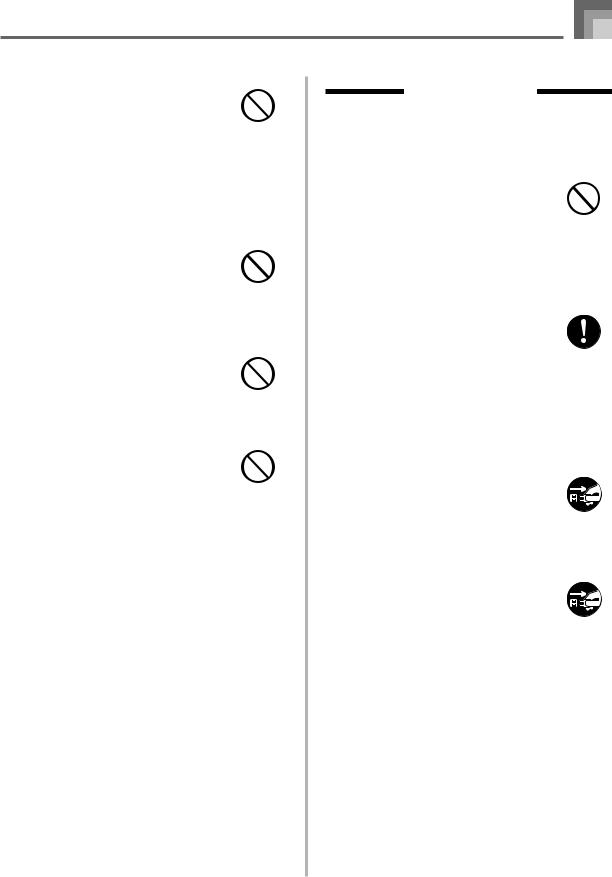
Safety Precautions
Dropping and Impact
Continued use of this product after it has been damaged by dropping or subjecting it to strong impact creates the risk of fire and electric shock. Take the following steps immediately.
1.Turn off power.
2.If you are using the AC adaptor for power, unplug it from the wall outlet.
3.Contact your original retailer or an authorized CASIO Service Provider.
Plastic Bags
Never place the plastic bag the product comes in over your head or in your mouth. Doing so creates the risk of suffocation.
Particular care concerning this precaution is required where small children are present.
Keep off of the product and stand.*
Climbing onto the product or stand can cause it to tip over or become damaged. Particular care concerning this precaution is required where small children are present.
Location
Avoid locating the product on an unstable stand, on an uneven surface, or any other unstable location. An unstable location can cause the product to fall over, creating the risk of personal injury.
 CAUTION
CAUTION
AC Adaptor
●Misuse of the AC adaptor creates the risk of fire and electric shock. Always make sure you observe the following precautions.
•Do not locate the electric cord near a stove or other sources of heat.
•Never pull on the cord when unplugging from the electrical outlet. Always grasp the AC adaptor when unplugging.
●Misuse of the AC adaptor creates the risk of fire and electric shock. Always make sure you observe the following precautions.
•Insert the AC adaptor into the wall outlet as far as it will go.
•Unplug the AC adaptor from the wall outlet during lightening storms or before leaving on a trip or other longterm absence.
•At least once a year, unplug the AC adaptor from the wall outlet and wipe away any dust that is built up in the area around the prongs of the plug.
Relocating the Product
Before relocating the product, always unplug the AC adaptor from the wall outlet and disconnect all other cables and connecting cords. Leaving cords connected creates the risk of damage to the cords, fire, and electric shock.
Cleaning
Before cleaning the product, always unplug the AC adaptor from the wall outlet first. Leaving the AC adaptor plugged in creates the risk of damage to the AC adaptor, fire, and electric shock.
Batteries
Misuse of batteries can cause them to leak resulting in damage to nearby objects, or to explode, creating the risk of fire and personal injury. Always make sure you observe the following precautions.
•Use only batteries that are specified for use with this product.
•Remove batteries from the product if you do not plan to use it for a long time.
E-3
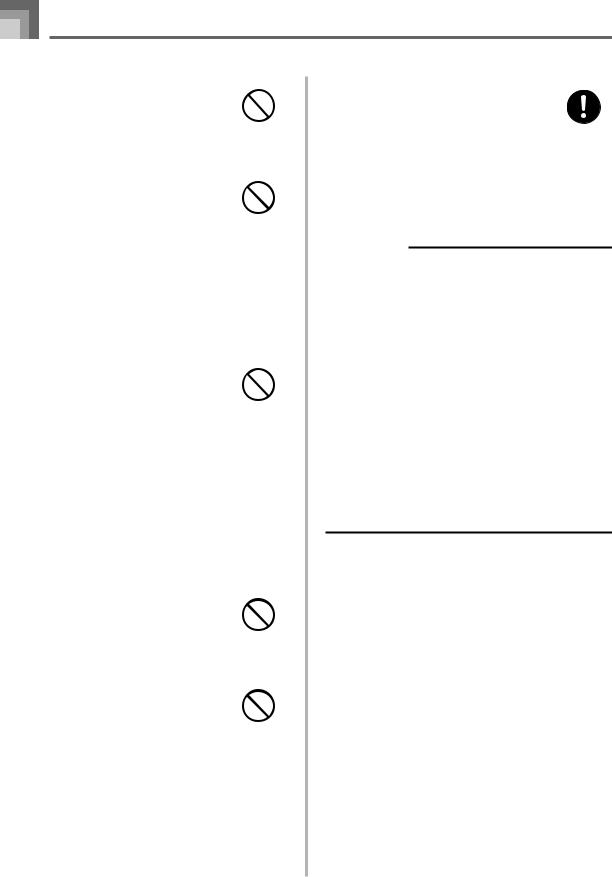
Safety Precautions
Connectors
Connect only the specified devices and equipment to the product’s connectors. Connection of a non-specified device or equipment creates the risk of fire and electric shock.
Location
Avoid the following locations for this product. Such locations create the risk of fire and electric shock.
•Areas subject to high humidity or large amounts of dust.
•In food preparation areas or other areas subject to oil smoke.
•Near air conditioning equipment, on a heated carpet, in areas exposed to direct sunlight, inside of a vehicle parked in the sun, or any other area that subjects the product to high temperatures.
Display Screen
•Never push on the display screen’s LCD panel or subject it to strong impact. Doing so can cause the LCD panel’s glass to crack, creating the risk of personal injury.
•Should the LCD panel ever crack or break, never touch the liquid inside of the panel. LCD panel liquid can cause skin irritation.
•Should LCD panel liquid ever get inside your mouth, immediately wash out your mouth with water and contact your physician.
•Should LCD panel liquid ever get into your eyes or onto your skin, rinse with clear water for at least 15 minutes, and then contact a physician.
Sound Volume
Do not listen to music at very loud volumes for long periods. Particular care concerning this precaution is required when using headphones. High volume settings can damage your hearing.
Heavy Objects
Never place heavy object on top of the product.
Doing so can make the product top heavy, causing the product to tip over or the object to fall from it, creating the risk of personal injury.
Correct Stand* Assembly
An incorrectly assembled stand can tip over, causing the product to fall and creating the risk of personal injury.
Make sure you assemble the stand correctly, following the assembly instructions that come with it. Make sure you mount the product on the stand correctly.
* Stand is available as an option.
IMPORTANT!
When using batteries, be sure to replace them or shift to one of the alternate power sources whenever you notice any of the following symptoms.
•Dim power indicator
•Instrument does not turn on
•Display that is flickering, dim, or difficult to read
•Abnormally low speaker/headphone volume
•Distortion of sound output
•Occasional interruption of sound when playing at high volumes
•Sudden power failure when playing at high volumes
•Flickering or dimming of the display when playing at high volume
•Continued sound output even after you release a key
•A tone that is totally different from the one that is selected
•Abnormal rhythm pattern and demo tune play
•Loss of power, sound distortion, or low volume when playing from a connected computer or external device
•Sudden power failure while reading from or writing to external storage media
E-4

Introduction
Congratulations upon your selection of this CASIO musical instrument. This keyboard provides you with the following features and functions.
620 Tones Include Rich Advanced Tones
A total of 400 Advanced Tones are programmed with DSP tones to make them richer and more powerful. Advanced tones like Stereo Piano and Tremolo Electric Piano enhance the Piano and Electric Piano tones to create a totally new sound.
50 Drawbar Organ Tones
In addition to the 620 standards tones, the keyboard also includes 50 realistic drawbar organ tones. Drawbar organ tones can be controlled using nine digital drawbars. You can also select percussion or key click, and even edit the parameters of preset tone and save up to 100 original tones in user tone memory.
Flash Memory
Built-in Flash memory lets you expand your selection of tones and rhythms by downloading data from the CASIO MUSIC SITE, or by the CD-ROM that comes bundled with the keyboard. You can also store up to 200 SMF format music files for playback.
PIANO SETTING Button
The press of a button optimizes the keyboard setup for piano play.
166 Preset Rhythms + 16 User Rhythms
A selection of 166 rhythms includes accompaniments for everything from rock to pops and jazz.
You can also transfer accompaniment data from your computer and store up to 16 of them as user rhythms in keyboard memory.
Auto Accompaniment
Simply play a chord and the corresponding rhythm, bass and chord parts play automatically. One-touch Preset instantly recalls the most suitable tone and tempo settings to match the rhythm you are using.
Big, Information-packed Display
A big built-in display shows chord names, tempo setting, keyboard information, staff notation of notes played, and more for full support of all your keyboard play. A built-in backlight keeps the display easy to read, even in total darkness.
Song Memory
Record up to six parts in memory, along with their tone, volume, pan position, and other parameters for later playback. Realistic ensemble play can also be created using the Auto Accompaniment function.
Synthesizer Mode
Edit built-in sounds to produce your own original creations. Up to 120 of your own sounds can be stored in memory for recall, just like the built-in tones.
General MIDI compatibility
The General MIDI tones of this keyboard let you connect to a personal computer to enjoy “desktop music” capabilities. This keyboard can be used as a desktop music input device or sound source, and it's just the thing for playback of commercially available pre-recorded General MIDI music software.
Powerful effects
A collection of powerful effects, such as DSP, reverb, chorus, and more, give you total control over the type of sound you want. You can even change the parameters of an effect to create your own, original effects. A 4-band equalizer is also included.
E-5
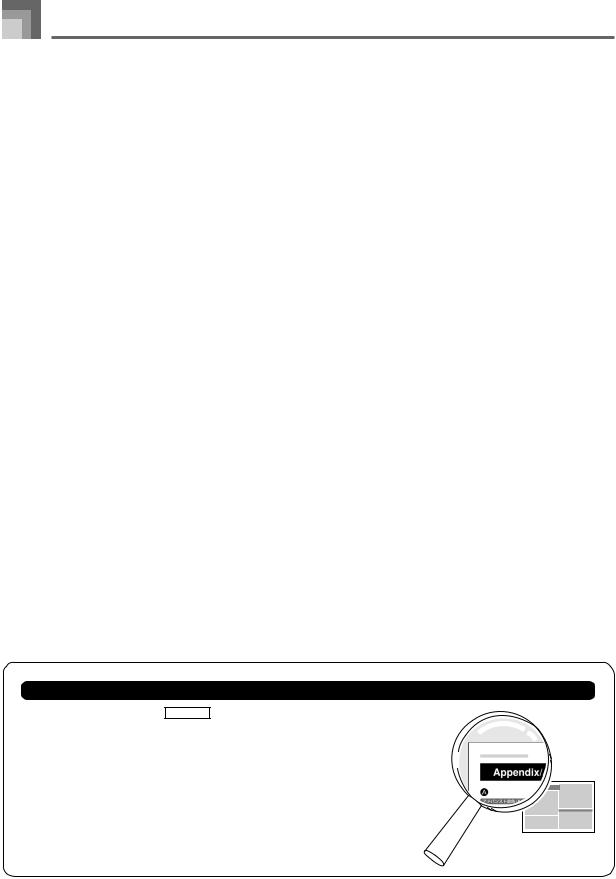
Introduction
USB port
A USB port provides quick and easy connection to a computer.*
* Note that you will need a commercially available USB cable (A-B type) to connect to a computer using the USB port.
Mixer
You can specify tone, volume, pan position, and other parameters for each built-in Auto Accompaniment part. You can also control the same parameters for each channel during MIDI input.
Registration Memory
Keyboard setups can be stored in memory for later recall and instant settings whenever you need them. Up to 32 setups (4 setups × 8 banks) can be stored in registration memory.
Data download from your computer (Internet Data Expansion System)
You can use your computer to download data from the CASIO MUSIC SITE.
SD Memory Card Slot
A built-in SD memory card slot helps to simplify transfer of data from a computer and lets you store volumes of data for later recall when you need it. You can also load a card with a standard MIDI file (SMF) and play it back on the keyboard.
Built-in floppy disk drive (WK-3800 only)
Save original tones or songs you created with the Song Memory to disk for long-term storage. You can also load a disk with a standard MIDI file (SMF) and play it back on the keyboard.
Using the Separate Appendix
Whenever you see the symbol Appendix in this manual, it means you should refer to the separate Appendix.
The letters Athrough Hindicate the section of the Appendix to which you should refer.
E-6

Contents
Safety Precautions ................ |
E-1 |
Introduction ........................... |
E-5 |
General Guide ...................... |
E-10 |
Attaching the Score Stand ..................... |
E-11 |
Playing a Demo Tune ............................. |
E-12 |
Power Supply ...................... |
E-14 |
Using batteries ....................................... |
E-14 |
Using the AC Adaptor ............................. |
E-15 |
Auto Power Off ....................................... |
E-15 |
Turning Off the Keyboard ....................... |
E-15 |
Memory Contents ................................... |
E-16 |
Connections ........................ |
E-17 |
Basic Operations ................. |
E-19 |
To play the keyboard .............................. |
E-19 |
Selecting a Tone..................................... |
E-19 |
PIANO SETTING Button ........................ |
E-20 |
Using the PITCH BEND Wheel .............. |
E-21 |
Using the MODULATION ....................... |
E-21 |
Using the Drawbar Organ |
|
Mode ..................................... |
E-22 |
To select a drawbar organ tone .............. |
E-24 |
To edit a drawbar organ tone ................. |
E-24 |
Parameter Details .................................. |
E-25 |
To save an edited drawbar organ tone..... |
E-26 |
Applying Effects to Tones .... |
E-27 |
Effect Blocks .......................................... |
E-27 |
Selecting a DSP Type ............................ |
E-28 |
About the DSP Button ............................ |
E-29 |
Selecting REVERB ................................ |
E-29 |
Selecting CHORUS ................................ |
E-30 |
Using the Equalizer ................................ |
E-31 |
Auto Accompaniment ......... |
E-32 |
About the MODE Button ........................ |
E-32 |
Selecting a Rhythm ................................ |
E-32 |
Playing a Rhythm ................................... |
E-33 |
Adjusting the Tempo ............................... |
E-33 |
Using Auto Accompaniment ................... |
E-33 |
Using an Intro Pattern ............................ |
E-36 |
Using a Fill-in Pattern ............................. |
E-36 |
Using a Rhythm Variation ....................... |
E-37 |
Synchro Starting Accompaniment with |
|
Rhythm Play ........................................... |
E-37 |
Finishing with an Ending Pattern ........... |
E-37 |
Using One-touch Preset ......................... |
E-38 |
Using Auto Harmonize ........................... |
E-38 |
Adjusting the Accompaniment Volume .... |
E-39 |
Mixer Function ..................... |
E-40 |
What you can do with the Mixer ............. |
E-40 |
Turning Channels On and Off ................ |
E-40 |
Using the Parameter Edit Mode ............. |
E-41 |
How Parameters Work ........................... |
E-42 |
E-7

Contents
Synthesizer Mode ................ |
E-44 |
Synthesizer Mode Functions .................. |
E-44 |
Creating a User Tone ............................. |
E-47 |
Storing a User Tone In Memory ............. |
E-50 |
Registration Memory .......... |
E-51 |
Registration Memory Features ............... |
E-51 |
To Save a Setup in Registration |
|
Memory .................................................. |
E-52 |
To Recall a Setup from Registration |
|
Memory .................................................. |
E-52 |
Song Memory Function ...... |
E-53 |
Tracks .................................................... |
E-53 |
Basic Song Memory operations ............. |
E-53 |
Using Real-time Recording .................... |
E-54 |
Playing Back from Song Memory ........... |
E-56 |
Recording Melody and Chords with |
|
Step Recording ...................................... |
E-56 |
Recording Multiple Tracks ...................... |
E-59 |
Correcting Mistakes While |
|
Step Recording ...................................... |
E-61 |
Editing Memory Contents ....................... |
E-62 |
Editing a Song ........................................ |
E-64 |
E-8
Keyboard Settings .............. |
E-66 |
Using Layer ............................................ |
E-66 |
Using Split .............................................. |
E-67 |
Using Layer and Split Together .............. |
E-68 |
Transposing the Keyboard ..................... |
E-69 |
Using Touch Response .......................... |
E-69 |
Tuning the Keyboard .............................. |
E-70 |
Changing Other Settings ........................ |
E-71 |
Using the SMF Player ......... |
E-75 |
Playing Back an SMF ............................. |
E-77 |
Configuring Other Settings ..................... |
E-78 |
Connection to a |
|
Computer ............................. |
E-80 |
General MIDI .......................................... |
E-81 |
MIDI Settings ......................................... |
E-81 |
Internet Data Expansion System ........... |
E-82 |
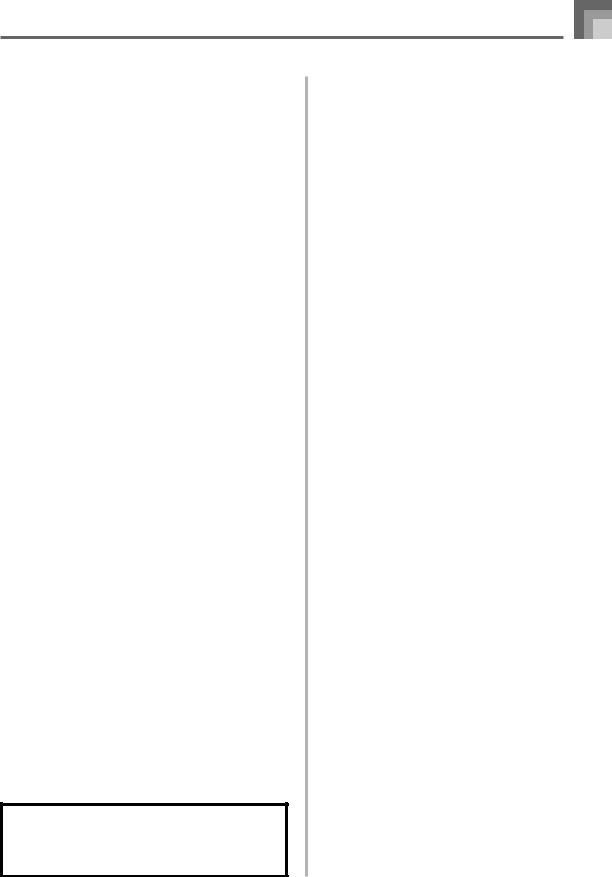
Contents
Saving Data .......................... |
E-83 |
Using an SD Memory Card .................... |
E-84 |
Using the Floppy Disk Drive |
|
(WK-3800 Only) ..................................... |
E-85 |
Using External Storage Media ............... |
E-87 |
Saving Files ........................................... |
E-88 |
Loading a File ........................................ |
E-90 |
Renaming a File ..................................... |
E-91 |
Deleting a File ........................................ |
E-92 |
Formatting External Storage Media ....... |
E-93 |
Inputting Characters ............................... |
E-94 |
SD Memory Card Error Messages ......... |
E-95 |
Disk Drive Error Messages |
|
(WK-3800 Only) ..................................... |
E-96 |
Troubleshooting .................. |
E-97 |
Specifications .................... |
E-100 |
Care of your Instrument ... E-103
MIDI messages that can be sent and received using the USB port
Company and product names used in this
manual may be registered trademarks of
others.
E-9
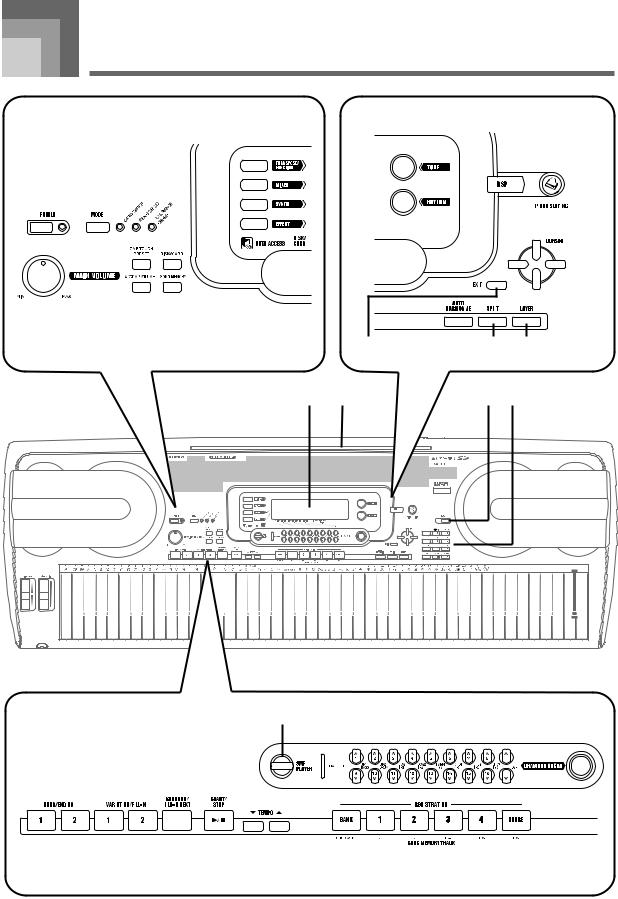
General Guide
1 2 3 |
|
|
|
4 5 6 7 |
D E |
|
F G H |
|||||||||||||||||||||||
|
|
|
|
|
|
|
|
|
|
|
|
|
|
|
|
|
|
|
|
|
|
|
|
|
|
|
|
|
|
|
|
|
|
|
|
|
|
|
|
|
|
|
|
|
|
|
|
|
|
|
|
|
|
|
|
|
|
|
|
|
|
|
|
|
|
|
|
|
|
|
|
|
|
|
|
|
|
|
|
|
|
|
|
|
|
|
|
|
|
|
|
|
|
|
|
|
|
|
|
|
|
|
|
|
|
|
|
|
|
|
|
|
|
|
|
|
|
|
|
|
|
|
|
|
|
|
|
|
|
|
|
|
|
|
|
|
|
|
|
|
|
|
|
|
|
|
|
|
|
|
|
|
|
|
|
|
|
|
|
|
|
|
|
|
|
|
|
|
|
|
|
|
|
|
|
|
|
|
|
|
|
|
|
|
|
|
|
|
|
|
|
|
|
|
|
|
|
|
|
|
|
|
|
|
|
|
|
|
|
|
|
|
|
|
|
|
|
|
|
|
|
|
|
|
|
|
|
|
|
|
|
|
|
|
|
|
|
|
|
|
|
|
|
|
|
|
|
|
|
|
|
|
|
|
|
|
|
|
|
|
|
|
|
|
|
|
|
|
|
|
|
|
|
|
|
|
|
|
|
|
|
|
|
|
|
|
|
|
|
|
|
|
|
|
|
|
|
|
|
|
|
|
|
|
|
|
|
|
|
|
|
|
|
|
|
|
|
|
|
|
|
|
|
|
|
|
|
|
|
|
|
|
|
|
|
|
|
|
|
|
|
|
|
|
|
|
|
|
|
|
|
|
|
|
|
|
|
|
|
|
|
|
|
|
|
|
|
|
|
|
|
|
|
|
|
|
|
|
|
|
|
|
|
|
|
|
|
|
|
|
|
|
|
|
|
|
|
|
|
|
|
|
|
|
|
|
|
|
|
|
|
|
|
|
|
|
|
|
|
|
|
|
|
|
|
|
|
|
|
|
|
|
|
|
|
|
|
|
|
|
|
|
|
|
|
|
|
|
|
|
|
|
|
|
|
|
|
|
|
|
|
|
|
|
|
|
|
|
|
|
|
|
|
|
|
|
|
|
|
|
|
|
|
|
|
|
|
|
|
|
|
|
|
|
|
|
|
|
|
|
|
|
|
|
|
|
|
|
|
|
|
|
|
|
|
|
|
|
|
|
|
|
|
|
|
|
|
|
|
|
|
|
|
|
|
|
|
|
|
|
|
|
|
|
|
|
|
|
|
|
|
|
|
|
|
|
|
|
8 |
|
|
|
|
|
|
|
|
9 0 A B |
C |
|
|
J K |
L |
|||||||||||||||||||||||||||||||||||||
|
|
|
|
|
|
|
|
|
|
|
|
|
|
|
|
|
|
|
|
|
|
|
|
|
|
|
|
|
|
I |
|
|
||||||||||||||||||||
|
|
|
|
|
M |
|
|
|
|
|
|
|
N |
|
|
O P *1 |
|
|
|
|
Q *2 |
|
M |
|||||||||||||||||||||||||||||
|
|
|
|
|
|
|
|
|
|
|
|
|
|
|
|
|
|
|
|
|
|
|
|
|
|
|
|
|
|
|
|
|
|
|
|
|
|
|
|
|
|
|
|
|
|
|
|
|
|
|
|
|
|
|
|
|
|
|
|
|
|
|
|
|
|
|
|
|
|
|
|
|
|
|
|
|
|
|
|
|
|
|
|
|
|
|
|
|
|
|
|
|
|
|
|
|
|
|
|
|
|
|
|
|
|
|
|
|
|
|
|
|
|
|
|
|
|
|
|
|
|
|
|
|
|
|
|
|
|
|
|
|
|
|
|
|
|
|
|
|
|
|
|
|
|
|
|
|
|
|
|
|
|
|
|
|
|
|
|
|
|
|
|
|
|
|
|
|
|
|
|
|
|
|
|
|
|
|
|
|
|
|
|
|
|
|
|
|
|
|
|
|
|
|
|
|
|
|
|
|
|
|
|
|
|
|
|
|
|
|
|
|
|
|
|
|
|
|
|
|
|
|
|
|
|
|
|
|
|
|
|
|
|
|
|
|
|
|
|
|
|
|
|
|
|
|
|
|
|
|
|
|
|
|
|
|
|
|
|
|
|
|
|
|
|
|
|
|
|
|
|
|
|
|
|
|
|
|
|
|
|
|
|
|
|
|
|
|
|
|
|
|
|
|
|
|
|
|
|
|
|
|
|
|
|
|
|
|
|
|
|
|
|
|
|
|
|
|
|
|
|
|
|
|
|
|
|
|
|
|
|
|
|
|
|
|
|
|
|
|
|
|
|
|
|
|
|
|
|
|
|
|
|
|
|
|
|
|
|
|
|
|
|
|
|
|
|
|
|
|
|
|
|
|
|
|
|
|
|
|
|
|
|
|
|
|
|
|
|
|
|
|
|
|
|
|
|
|
|
|
|
|
|
|
|
|
|
|
|
|
|
|
|
|
|
|
|
|
|
|
|
|
|
|
|
|
|
|
|
|
|
|
|
|
|
|
|
|
|
|
|
|
|
|
|
|
|
|
|
|
|
|
|
|
|
|
|
|
|
|
|
|
|
|
|
|
|
|
|
|
|
|
|
|
|
|
|
|
|
|
|
|
|
|
|
|
|
|
|
|
|
|
|
|
|
|
|
|
|
|
|
|
|
|
|
|
|
|
|
|
|
|
|
|
|
|
|
|
|
|
|
|
|
|
|
|
|
|
|
|
|
|
|
|
|
|
|
|
|
|
|
|
|
|
|
|
|
|
|
|
|
|
|
|
|
|
|
|
|
|
|
|
|
|
|
|
|
|
|
|
|
|
|
|
|
|
|
|
|
|
|
|
|
|
|
|
|
|
|
|
|
|
|
|
|
|
|
|
|
|
|
|
|
|
|
|
|
|
|
|
|
|
|
|
|
|
|
|
|
|
|
|
|
|
|
|
|
|
|
|
|
|
|
|
|
*3 R S T |
|
|
|
|
|
|
|
|
|
U |
|||||||||||||||||||||||||||||||
|
|
|
|
|
|
|
|
|
|
|
|
|
|
|
|
|
|
|
|
|
|
|
V |
|
|
|
|
W |
|
|
|
|
|
|
|
X |
|||||
|
|
|
|
|
|
|
|
|
|
|
|
|
|
|
|
|
|
|
|
|
|
|
|
|
|
|
|
|
|
|
|
|
|
|
|
|
|
|
|
|
|
|
|
|
|
|
|
|
|
|
|
|
|
|
|
|
|
|
|
|
|
|
|
|
|
|
|
|
|
|
|
|
|
|
|
|
|
|
|
|
|
|
|
|
|
|
|
|
|
|
|
|
|
|
|
|
|
|
|
|
|
|
|
|
|
|
|
|
|
|
|
|
|
|
|
|
|
|
|
|
|
|
|
|
|
|
|
|
|
|
|
|
|
|
|
|
|
|
|
|
|
|
|
|
|
|
|
|
|
|
|
|
|
|
|
|
|
|
|
|
|
|
|
|
|
|
|
|
|
|
|
|
|
|
|
|
|
|
|
|
|
|
|
|
|
|
|
|
|
|
|
|
|
|
|
|
|
|
|
|
|
|
|
|
|
|
|
|
|
|
|
|
|
|
|
|
|
|
|
|
|
|
|
|
|
|
|
|
|
|
|
|
|
|
|
|
|
|
|
|
|
|
|
|
|
|
|
|
|
|
|
|
|
|
|
|
|
|
|
|
|
|
|
|
|
|
|
|
|
|
|
|
|
|
|
|
|
|
|
|
|
|
|
|
|
|
|
|
|
|
|
|
|
|
|
|
|
|
|
|
|
|
|
|
|
|
|
|
|
|
|
|
|
|
|
|
|
|
|
|
|
|
|
|
|
|
|
|
|
|
|
|
|
|
|
|
|
|
|
|
|
|
|
|
|
|
|
|
|
|
|
|
|
|
|
|
|
|
|
|
|
|
|
|
|
|
|
|
|
|
|
|
|
|
|
|
|
Y |
Z |
[ \ ] |
a |
_ |
b |
c |
E-10
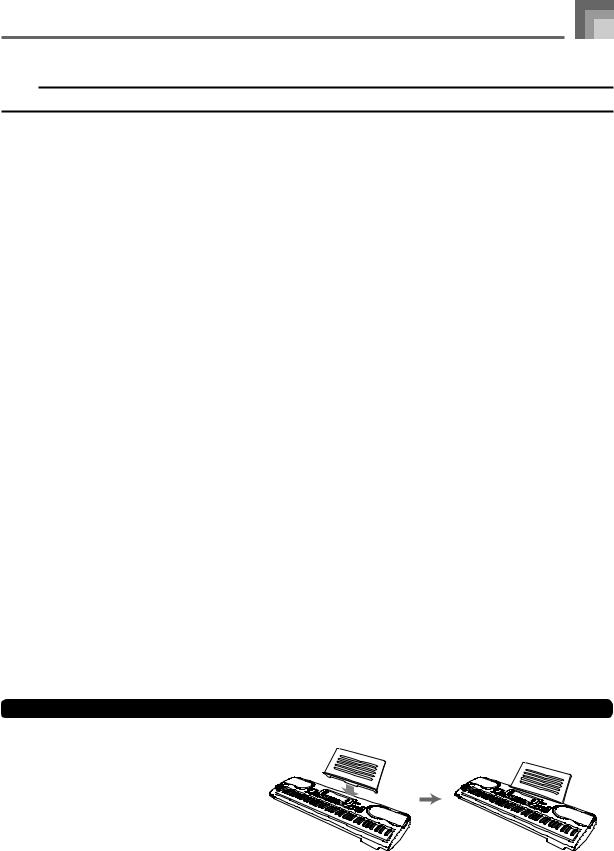
General Guide
NOTE
• Illustrations in this User’s Guide shows the WK-3800.
1 |
POWER button |
L LAYER button |
|
2 |
Power indicator |
M Speaker |
|
3 |
MODE button |
N Rhythm list |
|
4 |
EFFECT button |
O Tone list |
|
5 |
SYNTH button |
P Display |
|
6 |
MIXER button |
Q DEMO button*4 |
|
7 |
TRANSPOSE/FUNCTION button |
R WK-3800/WK-8000 |
|
8 |
MAIN VOLUME knob |
PHONES terminal |
|
|
|||
9 |
ONE TOUCH PRESET button |
WK-3300 |
|
PHONES/OUTPUT terminal |
|||
0 |
ACCOMP VOLUME button |
||
|
|||
A SONG MEMORY button |
S CHORD root names |
||
T Percussion instrument list |
|||
B WK-3800 |
|||
U Chord types name |
|||
|
DISK/CARD button |
||
|
|
||
|
WK-3300/WK-8000 |
V SMF PLAYER button |
|
|
|
||
|
CARD button |
W CHANNEL button (1~16, DSP)/drawbar buttons |
|
C DATA ACCESS lamp |
X DRAWBAR ORGAN button |
||
D RHYTHM button |
Y INTRO/ENDING 1/2 buttons |
||
E TONE button |
Z VARIATION/FILL-IN 1/2 buttons |
||
F DSP button |
[ SYNCHRO/FILL-IN NEXT button |
||
G PIANO SETTING button |
\ START/STOP button |
||
H [ ]/[ ]/[ ]/[ ] CURSOR buttons |
] TEMPO buttons |
||
I EXIT button |
_ SONG MEMORY TRACK buttons |
||
J AUTO HARMONIZE button |
a) BANK button |
||
|
|||
b) REGISTRATION buttons
K SPLIT button
c) STORE button
Attaching the Score Stand*1
Insert the score stand into the slot at the top of the keyboard as shown in the illustration.
E-11
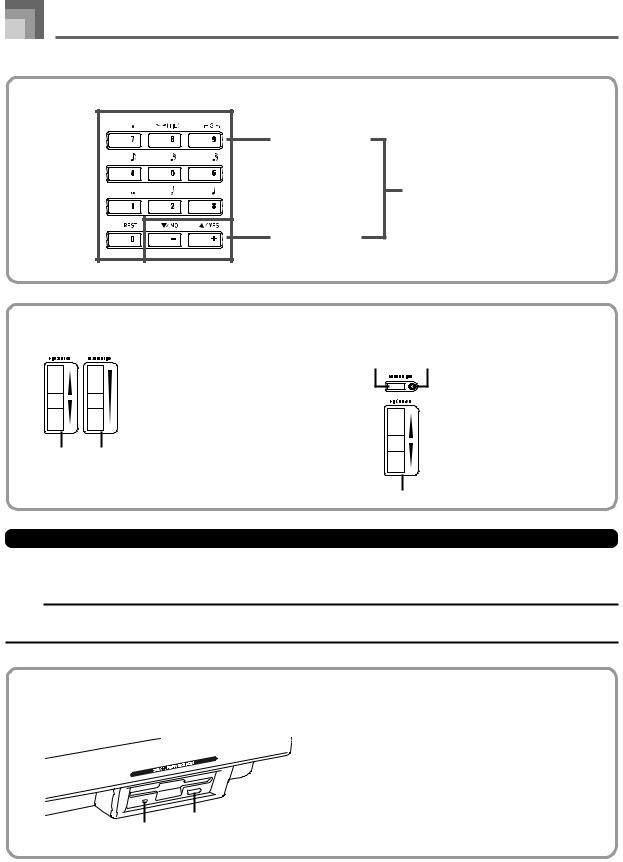
General Guide
*2
a Number buttons
b [+]/[–] buttons
(YES/NO)
*3
•For input of numbers to change displayed settings.
•Negative values can be changed only by using [+] and [–] to increment and decrement the displayed value.
• WK-3800/WK-8000 |
• WK-3300 |
|
c PITCH BEND wheel |
e |
f c PITCH BEND wheel |
d MODULATION wheel |
|
e MODULATION button |
|
|
f MODULATION button lamp |
c d
c
Playing a Demo Tune*4
Pressing the DEMO button starts demo tune play. There are 3 demo tunes, which continuously play in sequence. To stop demo tune play, press either the DEMO button or the START/STOP button.
NOTE
•Pressing the [+]/[–] buttons skips to the next demo tune.
•The PIANO SETTING button, Layer, and Split are disabled while a demo tune is playing.
Front Panel
• WK-3800 only
g Access lamp
h Eject button
h
g
E-12

General Guide
Rear Panel |
|
|
|
|
|
|||||||||
• WK-3800 |
• WK-3300 |
|
|
|||||||||||
i j k |
i |
k |
||||||||||||
|
|
|
|
|
|
|
|
|
|
|
|
|
|
|
|
|
|
|
|
|
|
|
|
|
|
|
|
|
|
|
|
|
|
|
|
|
|
|
|
|
|
|
|
|
|
|
|
|
|
|
|
|
|
|
|
|
|
|
|
i SUSTAIN/ASSIGNABLE JACK terminal |
i SUSTAIN/ASSIGNABLE JACK terminal |
|||||||||||||||||||||||
j LINE OUT R, LINE OUT L/MONO terminal |
k DC 12V terminal |
|||||||||||||||||||||||
k DC 12V terminal |
|
|
|
|
|
|
|
|
|
|
|
|
|
|
|
|
|
|
|
|||||
• WK-3300/WK-3800 |
|
|
|
|
|
|
|
• WK-8000 |
||||||||||||||||
|
|
|
l |
|
|
|
m |
i j k |
||||||||||||||||
|
|
|
|
|
|
|
|
|
|
|
|
|
|
|
|
|
|
|||||||
|
|
|
|
|
|
|
|
|
|
|
|
|
|
|
|
|
|
|
|
|
|
|
|
|
|
|
|
|
|
|
|
|
|
|
|
|
|
|
|
|
|
|
|
|
|
|
|
|
|
l SD memory card slot |
i SUSTAIN/ASSIGNABLE JACK terminal |
|||
m USB port |
j LINE OUT R, LINE OUT L/MONO terminal |
|||
|
k DC 12V terminal |
|||
|
|
m |
||
|
|
|
|
|
|
|
|
|
|
|
|
|
|
|
m USB port
Front Panel |
l |
|
• WK-8000 |
||
|
l SD memory card slot
NOTE
•Display examples shown in this User’s Guide are intended for illustrative purposes only. The actual text and values that appear on the display may differ from the examples shown in this User’s Guide.
•Due to LCD element characteristics, display contrast changes depending on the angle from which you view it. The initial default contrast setting is one that allows easy viewing for a musician seated directly in front of the display. You can also adjust the contrast to the level that suits your particular needs. For more information, see page E-74.
E-13
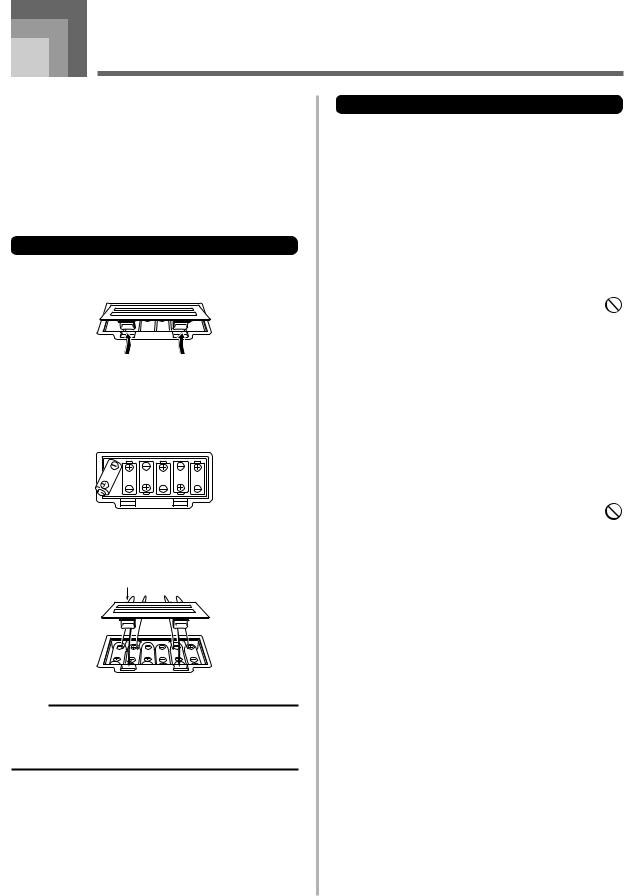
Power Supply
This keyboard can be powered by current from a standard household wall outlet (using the specified AC adaptor) or by batteries. Always make sure you turn the keyboard off whenever you are not using it.
Using batteries
Always make sure you turn off the keyboard before loading or replacing batteries.
To load batteries
1 Remove the battery compartment cover.
2Load six D-size batteries into the battery compartment.
•Make sure that the positive (+) and negative (–) ends are facing correctly.
3Insert the tabs on the battery compartment cover into the holes provided and close the cover.
tab
NOTE
•The keyboard may not function correctly if you load or replace batteries with power turned on. If this happens, turning the keyboard off and then back on again should return functions back to normal.
Important Battery Information
■The following shows the approximate battery life.
Alkaline batteries ............................. 4 hours
The above value is standard battery life at normal temperature, with the keyboard volume at a medium setting. Temperature extremes or playing at very loud volume settings can shorten battery life.
 WARNING
WARNING
Misuse of batteries can cause them to leak, resulting in damage to nearby objects, or to explode, creating the risk of fire and personal injury. Always make sure you observe the following precautions.
•Never try to take batteries apart or allow them to become shorted.
•Never expose batteries to heat or dispose of them by incineration.
•Never mix old batteries with new ones.
•Never mix batteries of different types.
•Do not charge the batteries.
•Make sure the positive (+) and negative (–) ends of the batteries are facing correctly.
 CAUTION
CAUTION
Misuse of batteries can cause them to leak resulting in damage to nearby objects, or to explode, creating the risk of fire and personal injury. Always make sure you observe the following precautions.
•Use only batteries that are specified for use with this product.
•Remove batteries from the product if you do not plan to use it for a long time.
E-14
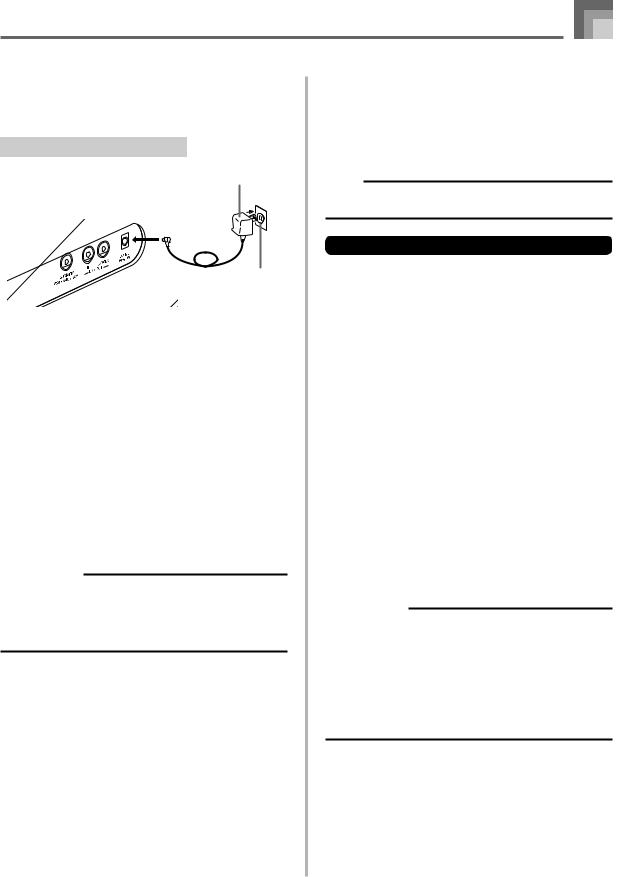
Power Supply
Using the AC Adaptor
Make sure that you use only the AC adaptor specified for this keyboard.
Specified AC Adaptor: AD-12
Example: WK-3800 |
AC adaptor AD-12 |
|
AC outlet
Note the following important precautions to avoid damage to the power cord.
●During Use
•Never pull on the cord with excessive force.
•Never repeatedly pull on the cord.
•Never twist the cord at the base of the plug or connector.
•The power cord should not be stretched tight while it is in use.
●During Movement
•Before moving the keyboard, be sure to unplug the AC adaptor from the power outlet.
●During Storage
•Loop and bundle the power cord, but never wind it around the AC adaptor.
IMPORTANT!
•Make sure that the keyboard is turned off before connecting or disconnecting the AC adaptor.
•Using the AC adaptor for a long time can cause it to become warm to the touch. This is normal and does not indicate malfunction.
Auto Power Off
When you are using battery power, keyboard power turns off automatically whenever you leave it on without performing any operation for about 6 minutes. When this happens, press the POWER button to turn power back on.
NOTE
•Auto Power Off is disabled (it does not function) when you are using the AC adaptor to power the keyboard.
To disable Auto Power Off
Hold down the TONE button while turning on the keyboard to disable Auto Power Off.
•When Auto Power Off is disabled, the keyboard does not turn off automatically no matter how long it is left with no operation being performed.
•Auto Power Off is automatically enabled whenever you turn on keyboard power.
Turning Off the Keyboard
•Be sure to press the POWER button to turn off power and make sure that the LCD backlight is off before disconnecting the AC adaptor or doing anything else.
•Never disconnect the AC adaptor while the keyboard is turned on or try to turn off power using any other technique besides pressing the POWER button. Doing so can cause the contents of the keyboard’s Flash memory to become corrupted. Strange keyboard operation and abnormal startup when power is turned on are symptoms of corrupted Flash memory contents. See “Troubleshooting” on page E-97 for more information.
IMPORTANT!
•While the following message is on the display, never turn off the keyboard by pressing the POWER button, disconnecting the AC adaptor, etc.
(message) “Pls Wait” or “Bulk In”
Turning off the keyboard while the above message is on the display can cause user data (user tones, song memory data, etc.) currently stored in keyboard memory or on external media to become corrupted. Once corrupted, you may not be able to recall the data again.
E-15

Power Supply
Memory Contents
Settings
Tone, rhythm, and other “main keyboard settings” in effect when you turn off the keyboard manually by pressing POWER button or when Auto Power Off turns off power are still in effect the next time you turn power back on.
Main Keyboard Settings
Tone number, layer, split, split point, drawbar organ tone settings, transpose, tuning, and contrast settings, touch response, reverb, chorus, DSP, equalizer, rhythm number, tempo, keyboard channel, MIDI In Chord Judge on/off, accomp MIDI out on/off, assignable jack setting, accompaniment volume, user area tones (Synthesizer Mode), user area accompaniments, user DSP area, pitch bend range, Auto Harmonize on/off, Auto Harmonize type, Mixer hold, DSP hold, Auto Accompaniment mode, all Mixer parameters, all Synthesizer Mode parameters, Song Memory song numbers, SMF player settings (play mode, manual play part, SMF playback volume)
Memory Contents
In addition to the above settings, data stored in the Registration Mode and Song Memory Mode is also retained when keyboard power is turned off.
Saving Setups and Memory Contents
About Flash memory
Your keyboard comes with built-in Flash memory, which can continue to hold data even when electrical power is totally cut off. This means that even after batteries go completely dead, you can attach the AC adaptor, turn on power, and still recall data stored in memory.
You can back up keyboard memory contents and other data using the media described below.
•SD Memory Card
See “Using an SD Memory Card” on page E-84.
•Floppy Diskette (WK-3800 only)
See “Using the Floppy Disk Drive (WK-3800 Only)” on page E-85.
•Computer hard disk
See “Connection to a Computer” on page E-80.
IMPORTANT!
•When running under battery power, be sure to replace batteries as soon as possible after the first signs of low battery power (dim power indicator lamp, dim display characters, etc.) Though the keyboard’s Flash memory is non-volatile (which means that data is not lost when power is interrupted), data can be lost if power suddenly fails while data is being written to flash memory*.
*While storing or deleting user data, while recording with the synthesizer, while transferring data from a computer, etc.
Initializing the Keyboard
Initialization can be used to return keyboard parameters to their initial factory default settings, or to delete all data currently in keyboard memory. See page E-74 for more information about initialization.
Returning the keyboard to its initial factory defaults
You can use the CD-ROM that comes with the keyboard and your computer to return the keyboard’s flash memory and all of its parameters to their initial factory default settings. See “Bundled CD-ROM Data” on page E-82 for details.
E-16
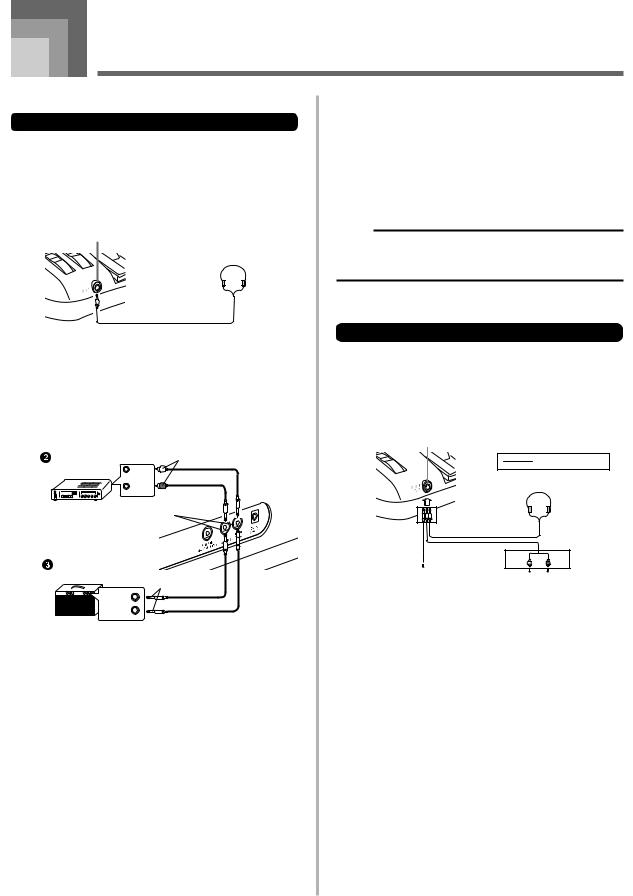
Connections
• WK-3800/WK-8000 |
|
Connecting to a Musical Instrument Amplifier 3 |
|
Phones and Line Out Terminals |
Use commercially available cords to connect to the two jacks |
||
as shown in Figure 3. It is up to you to purchase connecting |
|||
Before connecting phones or other external equipment, be |
|||
cables like the ones shown in the illustration for connection. |
|||
sure to first turn down the volume settings of the keyboard |
Use the keyboard’s MAIN VOLUME knob to adjust the |
||
and the connected equipment. You can then adjust volume |
volume level. |
||
to the desired level after connections are complete. |
• If your amplifier has only one input jack, connect a cord to |
||
[Front] |
|
the L/MONO jack only. |
|
|
|
||
PHONES Terminal |
|
NOTE |
|
|
• You can also connect the keyboard’s USB port to a |
||
|
|
||
|
|
computer or sequencer. See “Connection to a Computer” |
|
|
1 |
on page E-80 for details. |
|
|
|
• WK-3300 |
|
Stereo standard plug |
Phones/Output Terminal |
||
Connecting Phones 1 |
|
Before connecting phones or other external equipment, be |
|
|
sure to first turn down the volume settings of the keyboard |
||
Connecting phones cuts off output from the keyboard’s built- |
and the connected equipment. You can then adjust volume |
||
in speakers, so you can play even late at night without |
to the desired level after connections are complete. |
||
disturbing anyone. |
|
[Front] |
|
|
|
||
[Rear Panel] |
|
PHONES/OUTPUT Terminal |
|
|
|
||
Audio amplifier AUX IN, etc. |
PIN plug |
Audio connection |
|
LEFT |
|
|
|
(White) |
|
|
|
RIGHT |
|
|
|
(Red) |
|
1 |
|
|
|
||
Standard jacks |
Stereo standard |
|
plug |
|
|
|
|
|
|
|
|
|
|
|
White |
Red PIN plug |
|
|
|
|
|
|
|
|
|
|
|
|
|||
|
|
|
|
|
|
|
|
|
|
|
|||
|
Guitar amplifier, |
|
|
|
|
||||||||
|
3 |
|
|
2 |
|
|
|
||||||
|
keyboard amplifier, etc. |
Keyboard amp, |
|
LEFT |
RIGHT |
|
|||||||
|
|
Standard plugs |
|
guitar amp, etc. |
|
|
AUX IN or similar terminal |
|
|||||
|
|
INPUT 1 |
|
|
|
|
of audio amplifier |
|
|||||
|
|
|
|
|
|
|
|||||||
|
|
INPUT 2 |
|
|
|
|
|
|
|
||||
|
|
|
|
|
|
|
Connecting Phones 1 |
|
|
|
|
||
Connecting to Audio Equipment 2 |
Connecting phones cuts off output from the keyboard’s built- |
||||||||||||
in speakers, so you can play even late at night without |
|||||||||||||
Use commercially available cords to connect to the two jacks |
disturbing anyone. |
|
|
|
|
||||||||
as shown in Figure 2. It is up to you to purchase connecting |
Audio Equipment 2 |
|
|
|
|
||||||||
cables like the ones shown in the illustration for connection. |
|
|
|
|
|||||||||
Normally in this configuration, you must set the audio |
Connect the keyboard to a audio equipment using a |
||||||||||||
equipment’s input selector to the setting that specifies the |
commercially available connecting cord with a standard plug |
||||||||||||
terminal (such as AUX IN) that the keyboard is connected to. |
on one end and two PIN plugs on the other end. Note that |
||||||||||||
Use the keyboard’s MAIN VOLUME knob to adjust the |
the standard plug you connect to the keyboard must be a |
||||||||||||
volume level. |
stereo plug, otherwise you will be able to output only one of |
||||||||||||
|
|
|
|
|
|
|
stereo channels. In this configuration, you normally set the |
||||||
|
|
|
|
|
|
|
input selector of the audio equipment to the terminal (usually |
||||||
|
|
|
|
|
|
|
marked AUX IN or something similar) where the cord from |
||||||
|
|
|
|
|
|
|
the keyboard is connected. See the user documentation that |
||||||
|
|
|
|
|
|
|
comes with your audio equipment for full details. |
||||||
E-17
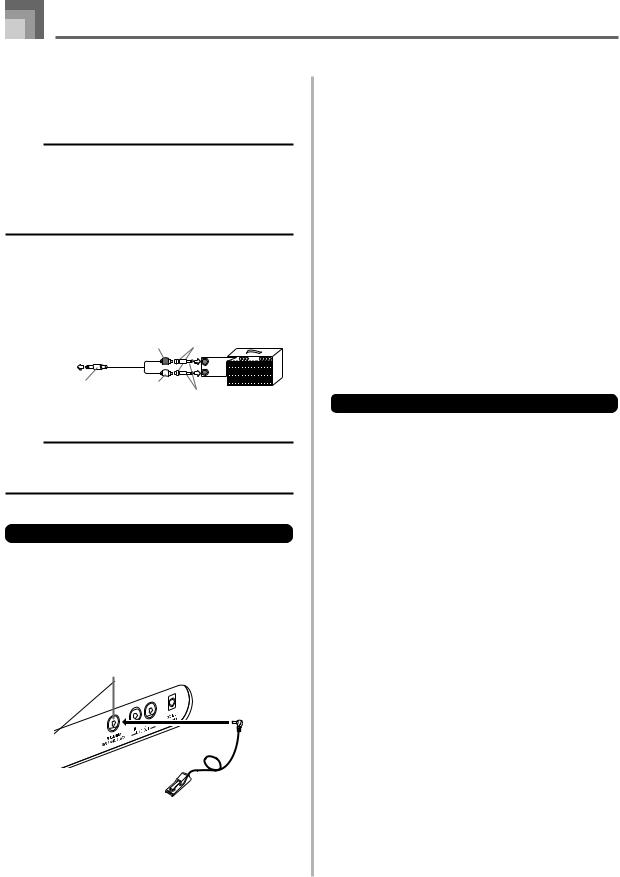
Connections
Musical Instrument Amplifier 3
Use a commercially available connecting cord to connect the keyboard to a musical instrument amplifier.
NOTE
•Be sure to use a connecting cord that has a stereo standard plug on the end you connect to the keyboard, and a connector that provides dual channel (left and right) input to the amplifier to which you are connecting. The wrong type of connector at either end can cause one of the stereo channels to be lost.
•When connected to a musical instrument amplifier, set the volume of the keyboard to a relatively low level and make output volume adjustments using the amplifier’s controls.
Connection Example
|
PIN plug (red) |
PIN jack |
To keyboard’s |
|
INPUT 1 |
PHONES/OUTPUT |
|
|
terminal |
|
INPUT 2 |
|
|
|
Stereo standard plug |
PIN plug (white) |
|
Standard plug |
Keyboard or |
|
guitar amp |
||
|
NOTE
•You can also connect the keyboard to a computer or sequencer. See “Connection to a Computer” on page E-80 for details.
Sustain/Assignable jack Terminal
You can connect an optional sustain pedal (SP-3 or SP-20) to the SUSTAIN/ASSIGNABLE JACK terminal to enable the capabilities described below.
For details on how to select the pedal function you want, see “Changing Other Settings” on page E-71.
Sustain Pedal
•With piano tones, depressing the pedal causes notes to linger, much like a piano’s damper pedal.
•With organ tones, depressing the pedal causes notes to continue to sound until the pedal is released.
Sostenuto Pedal
•As with the sustain pedal function described above, depressing the sostenuto pedal causes notes to be sustained.
•This difference between a sostenuto and sustain pedal is the timing. With a sostenuto pedal, you press the keys and then depress the pedal before you release the keys. Only the notes that are sounding when the pedal is depressed are sustained.
Soft Pedal
Depressing the pedal softens the sound of the notes being played.
Rhythm Start/Stop Pedal
In this case, the pedal performs the same functions as the START/STOP button.
Accessories and Options
Use only the accessories and options specified for this keyboard. Use of non-authorized items creates the danger of fire, electrical shock, and personal injury.
Example: WK-3800
SUSTAIN/ASSIGNABLE JACK Terminal
SP-20
E-18
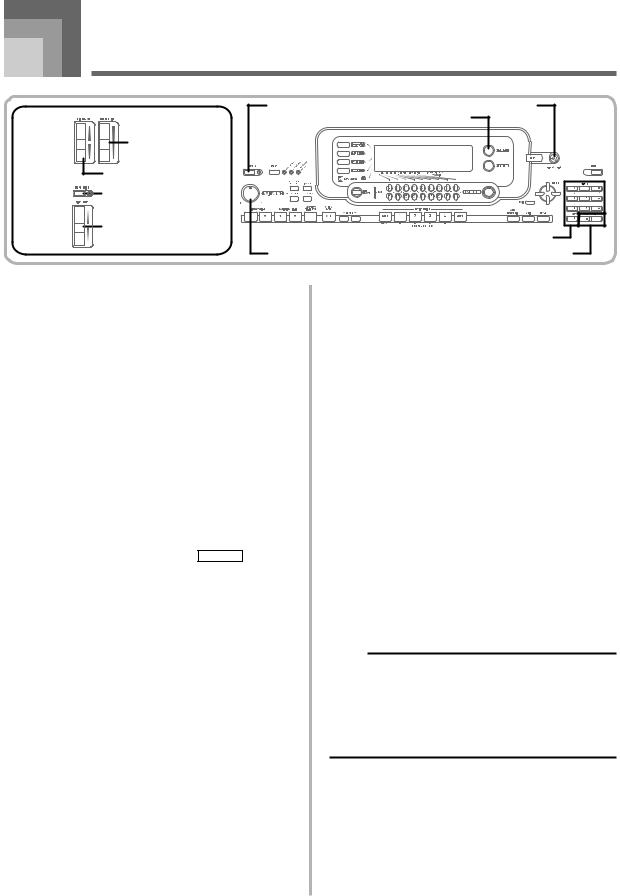
Basic Operations
|
POWER |
PIANO SETTING |
●WK-3800/ |
|
TONE |
WK-8000 |
|
|
|
MODULATION wheel |
|
|
PITCH BEND wheel |
|
●WK-3300 |
MODULATION button |
|
|
PITCH BEND wheel |
|
|
|
Number buttons |
|
MAIN VOLUME |
[+]/[–] |
This section provides information on performing basic keyboard operations.
To play the keyboard
1Press the POWER button to turn the keyboard on.
• This causes the power indicator to light.
2Use the MAIN VOLUME knob to set the volume to a relatively low level.
3 Play something on the keyboard.
Selecting a Tone
This keyboard comes with tones built-in, as shown below.
A partial list of the available tone names is printed on the keyboard console. See the separate Appendix A for a complete list. “Advanced Tones” are variations of standard tones, which are created by programming in effects (DSP) and other settings.
For details about drawbar organ tones, see “Using the Drawbar Organ Mode” on page E-22.
Tone Types
Standard Tones: 620 Preset Tones + 124 User Tones
Number |
Number |
Tone Type |
DSP Line |
|
of Tones |
On/Off*1 |
|||
000 - 399 |
400 |
Advanced Tones |
On |
|
400 - 599 |
200 |
Preset Tones |
Off |
|
|
|
|
|
|
600 - 619 |
20 |
Drum Sets |
Off |
|
|
|
|
|
|
700 - 799 |
100 |
User Tones*2 |
On/Off*3 |
|
800 - 819 |
20 |
User Tones with Waves*4 |
On/Off*3 |
|
900 - 903 |
4 |
User Drum Sets with |
On/Off*5 |
|
Waves*4 |
||||
|
|
|
Drawbar Organ Tones: 50 Preset Tones + 100 User Tones
Number |
Number |
Tone Type |
DSP Line |
of Tones |
On/Off*1 |
||
000 - 049 |
50 |
Preset Tones |
On/Off*5 |
100 - 199 |
100 |
User Tones*6 |
On/Off*3 |
*1: See “Changing Tones and Configuring DSP Effect Settings” on page E-20.
*2: Memory area for tones created by you. See “Synthesizer Mode” on page E-44. User tone areas 700 through 799 initially contain the same data as advanced tones 000 through 099.
*3: Depends on source tone or user setting. See “Synthesizer Mode” on page E-44 for more information.
*4: Area for data transferred from a computer. See “Internet Data Expansion System” on page E-82 for more information. For information about waveforms, see “Creating a User Tone” on page E-47.
*5: Depends on tone. This status can be checked by viewing the DSP button. See “About the DSP Button” on page E- 29 for more information.
*6: Memory area for tones created by you. See “To edit a drawbar organ tone” on page E-24. User drawbar organ tone areas initially contain two sets of the same data as drawbar organ tones types 000 through 049.
NOTE
•You cannot select tone numbers not included in the above range (standard tones 620 through 699 and 820 through 899, and drawbar organ tones from 050 to 099).
When you use the [+] and [–] buttons to scroll through tone numbers, scrolling jumps across the unused numbers. Pressing [+] when 619 is selected, for example, jumps to 700.
E-19
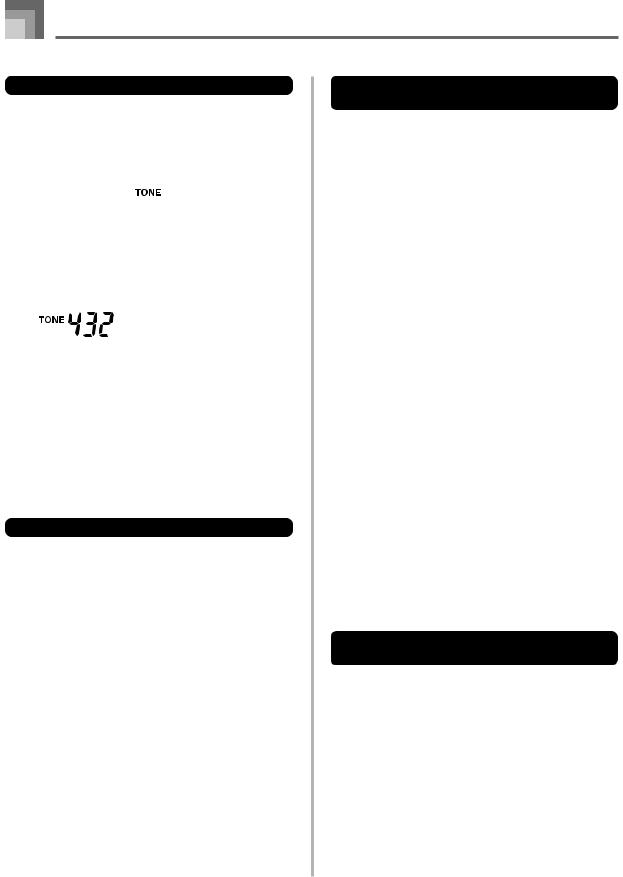
Basic Operations
|
To select a tone |
Changing Tones and Configuring |
|||||||||||||
1 Find the tone you want to use in the tone list (the |
DSP Effect Settings |
||||||||||||||
This keyboard has only a single DSP sound source. Because |
|||||||||||||||
|
|
|
separate |
|
|
A) and note its tone number. |
of this, selecting tones for which DSP is enabled for multiple |
||||||||
|
Appendix |
||||||||||||||
2 Press the TONE button. |
parts when layering or splitting tones (pages E-66, 67) can |
||||||||||||||
cause conflicts. To avoid conflicts, DSP is allocated to the last |
|||||||||||||||
|
|
|
|
|
|
|
|
|
|
|
|
|
|
DSP enabled tone, and DSP is disabled (DSP line OFF) for all |
|
|
|
|
|
|
|
|
|
|
|
|
|
|
|
other parts. |
|
|
|
|
|
|
|
|
|
|
|
|
|
|
|
DSP line is a parameter that controls whether or not the |
|
|
|
|
|
|
|
|
|
|
|
|
|
|
|
currently selected DSP effect is applied to a part.* Each tone |
|
|
|
|
|
|
|
|
|
|
|
|
|
|
|
||
|
|
|
|
|
|
|
|
|
|
|
|
|
|
has a DSP line parameter. Selecting a tone for a part applies |
|
3 Use the number buttons to input the three digit tone |
the tone’s DSP line parameter setting to all parts. |
||||||||||||||
|
|
|
number for the tone you want to select. |
* The DSP line parameter is turned on (DSP effect is applied) |
|||||||||||
|
|
|
for the 400 Advanced Tones numbered 000 through 399, |
||||||||||||
|
|
|
Example: To select “432 GM ACOUSTIC BASS”, input |
||||||||||||
|
|
|
and turned off (DSP effect not applied) for the 200 preset |
||||||||||||
|
|
|
|
4, 3 and then 2. |
|||||||||||
|
|
|
|
tones from 400 to 599. For information about other tones, |
|||||||||||
|
|
|
|
|
|
|
|
|
|
|
|
|
|
||
|
|
|
|
|
|
|
|
|
|
|
|
|
|
see “Tone Types” on page E-19. |
|
|
|
|
|
|
A c o u s B s G |
|
|
||||||||
|
|
|
|
|
|
|
|||||||||
NOTE |
|
|
|
|
|
|
|
|
|
|
PIANO SETTING Button |
||||
|
|
|
|
|
|
|
|
|
Pressing this button changes the setup of the keyboard to |
||||||
• |
Always input all three digits for the tone number, |
||||||||||||||
optimize it for piano play. |
|||||||||||||||
|
including leading zeros (if any). |
||||||||||||||
|
|
||||||||||||||
• |
You can also increment the displayed tone number by |
Settings |
|||||||||||||
|
pressing [+] and decrement it by pressing [–]. |
||||||||||||||
|
|
||||||||||||||
• |
When one of the drum sets is selected (tone numbers |
Tone Number: “000” |
|||||||||||||
|
600 through 619), each keyboard key is assigned a |
Rhythm Number: “140” |
|||||||||||||
|
different percussion sound. See the separate |
|
|
|
Accompaniment Mode: Normal |
||||||||||
|
Appendix |
||||||||||||||
|
B for details. |
Layer: Off |
|||||||||||||
|
|
|
|
|
|
|
|
|
|
|
|
|
|
Split: Off |
|
|
|
|
|
|
|
|
|
|
|
|
|
|
|
||
|
|
|
|
|
|
|
|
|
|
|
|
|
|
Auto Harmonize: Off |
|
|
Polyphony |
Transpose: 0 |
|||||||||||||
|
Touch Response: |
||||||||||||||
The term polyphony refers to the maximum number of notes |
Off: Returns to initial default |
||||||||||||||
On: No change |
|||||||||||||||
you can play at the same time. The keyboard has 32-note |
|||||||||||||||
Assignable Jack: SUS |
|||||||||||||||
polyphony, which includes the notes you play as well as the |
|||||||||||||||
Local Control: On |
|||||||||||||||
rhythms and auto-accompaniment patterns that are played |
|||||||||||||||
Mixer Channel 1 Parameter Setup: Depends on tone |
|||||||||||||||
by the keyboard. This means that when a rhythm or auto- |
|||||||||||||||
|
|||||||||||||||
accompaniment pattern is being played by the keyboard, the |
|
||||||||||||||
number of notes (polyphony) available for keyboard play is |
To optimize keyboard settings for |
||||||||||||||
reduced. Also note that some of the tones offer only 10-note |
|||||||||||||||
polyphony. |
piano play |
||||||||||||||
1 Press the PIANO SETTING button.
2 Now try playing something on the keyboard.
• The notes you play will sound with a piano tone.
• If you want to play with rhythm accompaniment, press the START/STOP button. This causes a rhythm that is optimized for piano will start to play.
• To stop rhythm play, press the START/STOP button again.
E-20

Basic Operations
NOTE
•Pressing the PIANO SETTING button while a rhythm is playing stops rhythm play and then changes the keyboard setup.
•Pressing the PIANO SETTING button while the keyboard is in the Synthesizer Mode or other mode exits the current mode and then changes the keyboard setup.
•The setup of the keyboard does not change if you press the PIANO SETTING button when any one of the following exists.
*During real-time recording, step recording, or while using the editing function of the Song Memory
*While the data save or overwrite message is on the display
*During demo tune play
Using the PITCH BEND Wheel
As its name suggests, the PITCH BEND wheel lets you “bend” the pitch of a sound. This makes it possible to add a touch of realism to saxophone and other tones.
To use the PITCH BEND wheel
1While holding down a keyboard key with your right hand, use your left hand to rotate the PITCH BEND wheel up and down.
•Releasing the PITCH BEND wheel returns the note to its original pitch.
NOTE
•With saxophone and electrical guitar tones, the most realistic sounding effects can be produced if you play notes and operate the PITCH BEND wheel simultaneously.
•See “Pitch Bend Range (Initial Default: 12)” on page
E-74 for changing the bend range of the PITCH BEND wheel.
•Never turn on keyboard power while the PITCH BEND wheel is rotated.
Using the MODULATION
Modulation applies vibrato, which modulates the pitch of a note. It works best with notes that are sustained (held) by keeping a keyboard key held down, especially when playing the melody with a violin or other similar tone.
You can modify the modulation effect using DSP parameter 0 through 7. For more information, see “DSP Parameters” on page E-28.
• WK-3800/WK-8000
To use the MODULATION Wheel
1While playing melody notes with your right hand, rotate the MODULATION wheel with your left hand to apply vibrato to the notes.
•The amount of vibrato applied depends on how far you rotate the MODULATION wheel upwards. Setting the wheel to its neutral position (rotated as far downwards as it can go) turns vibrato off.
• WK-3300
To use the MODULATION button
1While holding down a keyboard key with your right hand, use your left hand to press the MODULATION button.
•Vibrato is applied as long as the MODULATION button is depressed.
NOTE
•Modulation can be used to add greater expression to sustained melody notes being played using a violin, synthetic reed, or other similar tone.
•Modulation affects different tones in different ways.
E-21

Using the Drawbar Organ Mode
Your keyboard has built-in “drawbar organ tones” that can be altered using nine digital drawbars whose operations are similar to the controls on a drawbar organ. You can also select percussion or key click. There is room in memory for storage of up to 100 user-created drawbar tone variations.
Drawbar Organ Mode Operational Flow
Tone/Rhythm Selection Screeen*
|
|
|
|
|
|
|
|
|
|
|
|
|
|
|
|
|
|
|
DRAWBAR ORGAN button |
|
EXIT button |
||||||||||||||||
|
||||||||||||||||||
|
|
|
|
|
|
|
|
|
|
|
|
|
|
|
|
|||
|
|
|
|
Drawbar Organ Tone Selection Screen |
|
|
|
|
||||||||||
|
|
|
|
|
|
|
|
|
|
|
|
|
|
|
|
|
||
|
|
[ ] CURSOR button |
|
DRAWBAR ORGAN button |
||||||||||||||
|
|
|
||||||||||||||||
|
|
|
|
|
|
|
|
|
|
|
|
|
|
|
|
|
|
|
[ ] / [ ] CURSOR buttons |
|
|
|
Drawbar Organ Tone Editing Screen |
|
|
|
[ ] / [ ] CURSOR buttons |
||||||||||
|
|
|
|
|
|
|
|
|
|
|
|
|
||||||
|
|
|
|
|
|
|
|
|
|
|
|
|
|
|
|
|
|
|
|
|
|
|
|
|
|
|
“More?” Screen |
|
|
|
|
|
|
|
|
||
|
|
|
|
|
|
|
|
|
|
|
|
|
|
|
|
|
|
|
|
|
[ ] CURSOR button |
|
[ ] CURSOR button |
||||||||||||||
|
|
|
||||||||||||||||
|
|
|
|
|
|
|
|
|
|
|
|
|
|
|
|
|
|
|
|
|
|
|
|
|
Synthesizer Editing Screen |
|
|
|
|
|
|||||||
|
|
[ ] CURSOR button |
|
[ ] CURSOR button |
||||||||||||||
|
|
|
||||||||||||||||
|
|
|
|
|
|
|
|
|
|
|
|
|
|
|
|
|
|
|
|
|
|
|
|
|
DSP Effect Editing Screen |
|
|
|
|
|
|||||||
|
|
[ ] CURSOR button |
|
[ ] CURSOR button |
||||||||||||||
|
|
|
||||||||||||||||
|
|
|
|
|
|
|
|
|
|
|
|
|
|
|
|
|
|
|
Name/Save Setting Screen
*You can also display the drawbar organ tone selection screen from the Song Memory Mode or SMF Playback Mode screen. In this case, however, the Drawbar Organ Tone Editing Screen does not appear.
E-22
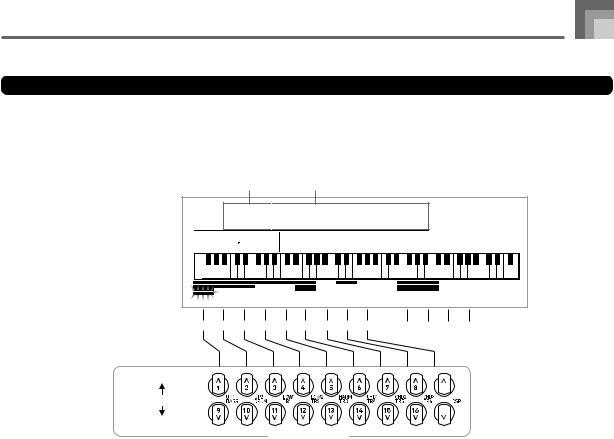
Using the Drawbar Organ Mode
Channel Buttons while the Drawbar Organ Tone Selection Screen is Displayed
The 18 buttons along the bottom of the display function as drawbar buttons while the drawbar organ tone selection screen is on the display (after you press the DRAWBAR ORGAN button). Each pair of buttons (upper and lower) represents a drawbar, which means that the 18 buttons provide you with the function of nine drawbars.
“ ’ ”: Feet
Value Parameter Name


 F t 1 6 ’
F t 1 6 ’
Currently selected 
 parameter
parameter
16' |
|
51/3' |
|
8' |
|
4' |
|
22/3' |
|
2' |
|
13/5' |
|
11/3' |
|
1' |
CLICK SECOND THIRD DECAY |
|
|
|
|
|
|
|
|
|
|
|
|
|
|
|
|
|
PERCUSSION |
Decrease
Currently selected drawbar
Increase
Drawbar buttons
Each of the nine button pairs is assigned values ranging from 16 feet to 1 foot. Each button pair has a decrease button (for decreasing by 16 feet, 5-1/3 feet, etc.) and an increase button (for increasing by 16 feet, 5-1/3 feet, etc.).
E-23

Using the Drawbar Organ Mode
To select a drawbar organ tone
1Find the drawbar organ tone you want to use in the tone list (the separate Appendix A) and note its tone number.
2Press the DRAWBAR ORGAN button.
•This causes the drawbar organ tone selection screen to appear.
Tone Number |
Tone Name |





 D r a w b a r 1
D r a w b a r 1
3Use the number buttons to input the three digit tone number for the tone you want to select.
NOTE
•Always input all three digits for the tone number, including leading zeros (if any).
•You can also increment the displayed tone number by pressing [+] and decrement it by pressing [–].
•When using a drawbar organ tone, playing a note that is outside the range of the tone you are using, the keyboard automatically plays the same note in the nearest octave that falls within the playable range.
To edit a drawbar organ tone
1Select the drawbar organ tone (000 to 049, 100 to 199) you want to edit.
DRAWBAR ORGAN
Number buttons
[+]/[–]
CURSOR
2Use the [ ] and [ ] CURSOR buttons to display the drawbar organ tone editing screen. Select the parameter whose setting you want to change.
Example: Selecting the “Ft16’” parameter
Parameter Setting Parameter Name


 F t 1 6 ’
F t 1 6 ’
•There are a total of 13 parameters. You can use the [ ] and [ ] CURSOR buttons to cycle through them. See “Parameter Details” on page E-25 for more information.
•While the “More?” screen is on the display, you can
advance to the synthesizer and DSP effect editing screens by pressing the [ ] CURSOR button or the [+] button.
3Use the [ ] and [ ] CURSOR buttons or the [+] and [–] buttons to change the setting of the currently displayed parameter.
•You can also change a parameter setting by entering a value with the number buttons.
•You can monitor the changes in a tone by playing notes on the keyboard as you adjust parameter settings.
NOTE
•Selecting a different tone after you edit parameters replaces parameter settings with those of the newly selected tone.
•If you have drawbar organ tones assigned to more than one channel, changing the drawbar organ setting for one of the channels causes the same setting to be applied to all of the other channels as well.
•See “To save an edited drawbar organ tone” on page
E-26 for information about saving your edits.
E-24
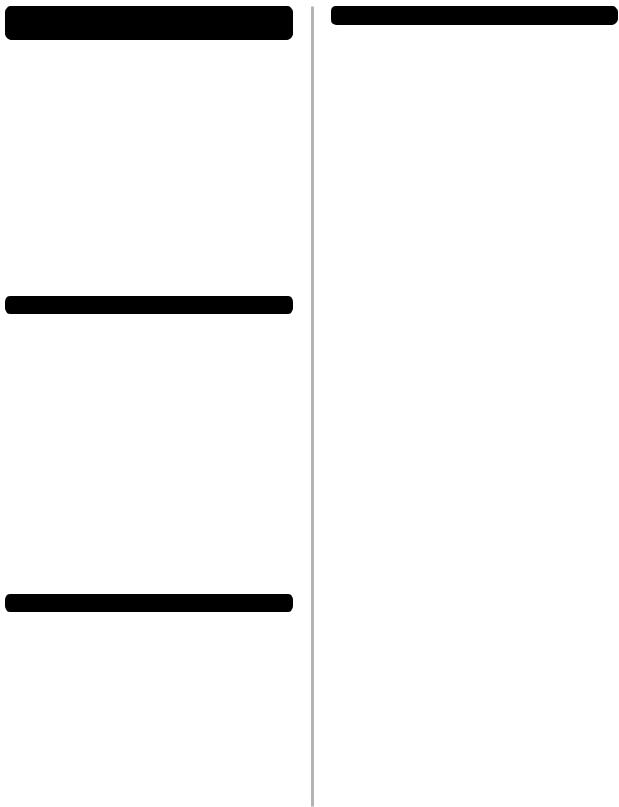
|
|
|
|
Using the Drawbar Organ Mode |
|
|
|
||||
|
|
|
|
|
|
|
|||||
|
|
|
|
|
|
|
|||||
|
|
|
|
|
|
|
|
|
|
|
|
Editing Synthesizer Mode Parameters |
Percussion |
|
|
|
|
|
|
||||
and DSP Parameters of Drawbar Tones |
This parameter lets you add percussion sound, which |
||||||||||
As with standard (non-drawbar) tones, you can edit the |
provides modulation to sustained tones that you create. When |
||||||||||
Synthesizer Mode parameters and DSP parameters of |
you hold down a key on the keyboard, the sound produced |
||||||||||
drawbar organ tones. See “Drawbar Organ Mode Operational |
decays until it is no longer audible. Pressing the key again |
||||||||||
Flow” on page E-22. |
|
|
sounds the note again at a louder volume. Percussion has |
||||||||
1 Use the [ ] and [ ] CURSOR buttons to display |
“2nd Percussion” (2nd overtone pitch) and “3rd Percussion” |
||||||||||
(3rd overtone pitch) settings, each of which can be turned on |
|||||||||||
“More?”, and then press the [ ] CURSOR button. |
or off. |
|
|
|
|
|
|
||||
• This enters the Synthesizer Mode, which is indicated |
You can also specify the percussion decay time, which controls |
||||||||||
how long it takes for the percussion sound to decay. |
|||||||||||
by the indicator next to SYNTH on the display screen. |
|||||||||||
|
|
|
|
|
|
|
|||||
• For the remainder of this procedure, perform the steps |
|
|
|
|
|
|
|
||||
starting from step 3 under “Creating a User Tone” on |
Parameter Name |
Parameter Display |
Settings |
||||||||
page E-47. |
|
|
|
Indication |
|||||||
|
|
|
|
|
|
|
|
|
|||
Parameter Details |
|
|
2nd Percussion |
Second |
oFF .... Off |
||||||
|
|
|
|
||||||||
|
|
3rd Percussion |
Third |
on ....... On |
|||||||
The following provides details about the parameters you can |
|||||||||||
|
|
|
|
|
|||||||
|
|
|
|
|
|
|
|||||
configure using the drawbar organ tone editing screen. |
|
|
|
|
|
|
|
||||
Percussion |
Decay |
000 to 127 |
|||||||||
|
|
|
|
||||||||
|
|
|
|
Decay Time |
|||||||
|
|
|
|
|
|
|
|
|
|
||
Drawbar Position |
|
|
|
|
|
|
|
|
|
||
This parameter defines the position of each drawbar, and the |
|
|
|
|
|
|
|
||||
volume of each overtone. The larger the value, the greater |
|
|
|
|
|
|
|
||||
the corresponding overtone’s volume. |
|
|
|
|
|
|
|
|
|
||
|
|
|
|
|
|
|
|
|
|
|
|
Parameter Name |
Parameter Display |
Settings |
|
|
|
|
|
|
|
|
|
|
Indication |
|
|
|
|
|
|
|
|
|
|
Drawbar 16’ |
Ft 16’ |
0 to 3 |
|
|
|
|
|
|
|
|
|
|
|
|
|
|
|
|
|
|
|
|
|
Drawbar 5 1/3’ |
Ft 5 1/3’ |
0 to 3 |
|
|
|
|
|
|
|
|
|
|
|
|
|
|
|
|
|
|
|
|
|
Drawbar 8’ |
Ft 8’ |
0 to 3 |
|
|
|
|
|
|
|
|
|
Drawbar 4’ |
Ft 4’ |
0 to 3 |
|
|
|
|
|
|
|
|
|
Drawbar 2 2/3’ |
Ft 2 2/3’ |
0 to 3 |
|
|
|
|
|
|
|
|
|
|
|
|
|
|
|
|
|
|
|
|
|
Drawbar 2’ |
Ft 2’ |
0 to 3 |
|
|
|
|
|
|
|
|
|
|
|
|
|
|
|
|
|
|
|
|
|
Drawbar 1 3/5’ |
Ft 1 3/5’ |
0 to 3 |
|
|
|
|
|
|
|
|
|
|
|
|
|
|
|
|
|
|
|
|
|
Drawbar 1 1/3’ |
Ft 1 1/3’ |
0 to 3 |
|
|
|
|
|
|
|
|
|
|
|
|
|
|
|
|
|
|
|
|
|
Drawbar 1’ |
Ft 1’ |
0 to 3 |
|
|
|
|
|
|
|
|
|
(Ft: Feet) |
|
|
|
|
|
|
|
|
|
|
|
Click
The parameter determines whether or not a key click is added when a sustained tone configured using the drawbars is played.
Parameter Name |
Parameter Display |
Settings |
|
|
Indication |
|
|
Click |
Click |
oFF .... Click Off |
|
on ....... Click On |
|||
|
|
E-25
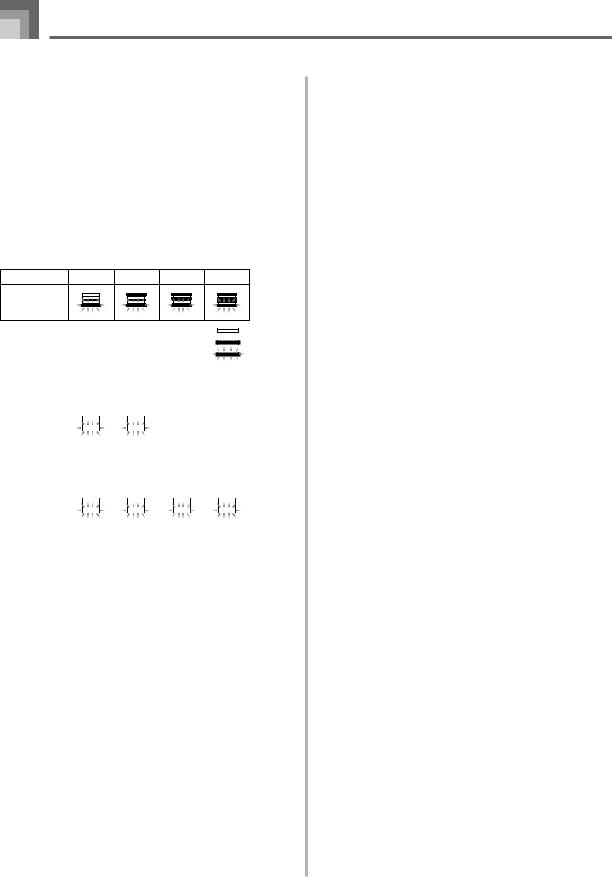
Using the Drawbar Organ Mode
Display Contents in the Drawbar Organ Mode
In the Drawbar Organ Mode, the current status of the drawbar positions, key click, and percussion parameters are indicated on the display’s bar graph as shown in the illustrations below. There is one line for each parameter, and the bottom segment of the selected parameter line flashes.
The bottom segment of the bar graph column that represents the currently selected parameter flashes to indicate that it is selected.
None of the channel numbers (1 to 16) are displayed in the drawbar organ tone mode and editing mode.
Drawbar Position Graph
Setting Value |
0 |
1 |
2 |
3 |
Display
Off
On
Blink
Click and Percussion On/Off Graph
Setting Value |
|
Off |
|
|
On |
|
Display |
|
|
|
|
|
|
|
|
|
|
|
|
|
Percussion Decay Time Graph
Setting Value |
|
0-31 |
32-63 |
64-95 |
96-127 |
|||||||
|
|
|
|
|
|
|
|
|
|
|
|
|
Display |
|
|
|
|
|
|
|
|
|
|
|
|
|
|
|
|
|
|
|
|
|
|
|
|
|
To save an edited drawbar organ tone
1After editing parameters, use the [ ] and [ ] CURSOR buttons to display “More?”.
2Press the [ ] CURSOR button three times to display the screen for inputting a tone name and assigning a tone number.
3Use the [+] and [–] buttons or the number buttons to select a tone number.
•You can select a tone number in the range of 100 to 199.
4After the tone name is the way you want, press the [ ] CURSOR button to store the tone.
•Use the [+] and [–] buttons to scroll through letters at the current cursor location.
•Use the [ ] and [ ] CURSOR buttons to move the cursor left and right.
•See the page E-94 for information about inputting text.
5After everything is the way you want, press the [ ] CURSOR button to store the tone.
•This will display a confirmation message asking whether you really want to save the data. Press the YES button to save the data.
•After the save operation is complete, the message “Complete” appears and then the display returns to the tone selection screen.
•To cancel save, press the EXIT button.
E-26
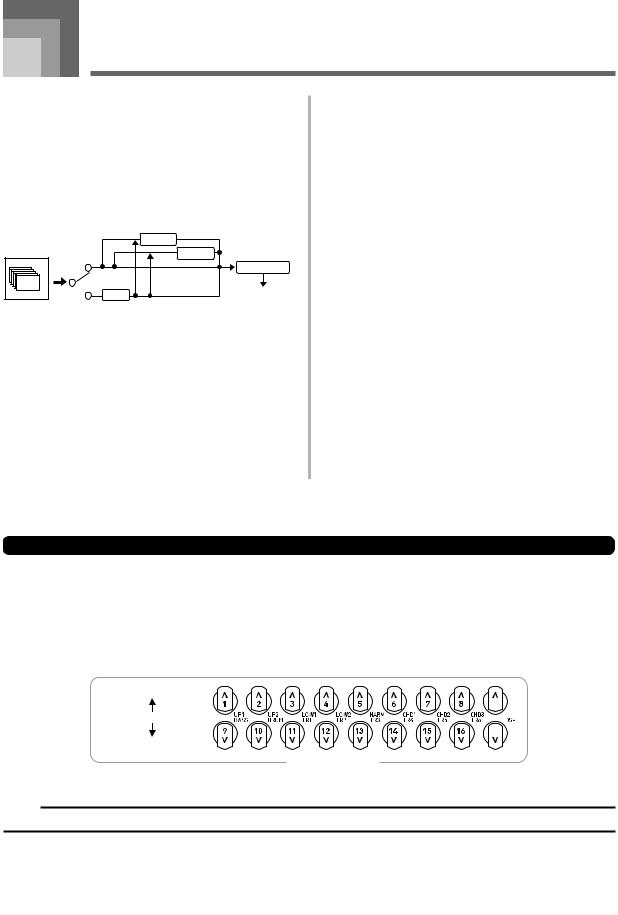
Applying Effects to Tones
This keyboard provides you with a selection of effects that you can apply to tones.
The built-in effects include a wide variety of variations that give you access to a selection of general digital effects.
Effect Blocks
The following shows how the effects of this keyboard are organized.
|
DSP button |
REVERB |
|
|
CHORUS |
Sound Source |
|
EQUALIZER |
|
off |
|
|
|
|
|
on |
Output |
16ch |
DSP |
DSP Line
DSP
DSP effects are applied to the connection between the sound source and output. You can select distortion and modulation effects. You can create DSP effect setups and also transfer downloaded DSP data from your computer. The keyboard has memory that lets you store up to 100 DSP effect setups. See “Internet Data Expansion System” on page E-82 and “Saving the Settings of DSP Parameters” on page E-29 for more information.
REVERB
Reverb simulates the acoustics of specific types of environments. You can choose from among 16 different reverb effects, including “Room” and “Hall”.
CHORUS
The chorus effect gives sound greater depth by causing it to vibrate. You can choose from among 16 different chorus effects, including “Chorus” and “Flanger”.
EQUALIZER
The equalizer is another type of effect that you can use to make adjustments in tone quality. Frequencies are divided among a number of bands, and raising and lowering the level of each frequency band alters the sound.
You can reproduce the optimal acoustics for the type of music you are playing (classics, for example) by selecting the applicable equalizer setting.
Channel Buttons while the Effect Mode Screen is Displayed
In the Effect Mode, the 18 buttons along the bottom of the display screen control the type and parameters of each effect, a shown in the illustration below.
Effect type |
Parameter 1 |
Parameter 3 |
Parameter 5 |
Parameter 7 |
|||||
|
Parameter 0 |
Parameter 2 |
Parameter 4 |
Parameter 6 |
|
||||
|
|
|
|
|
|
|
|
|
|
Increase
Currently selected parameter
Decrease
CHANNEL buttons
NOTE
• Pressing the [ ] and [ ] CURSOR buttons at the same time returns the currently selected effect to its preset value.
E-27
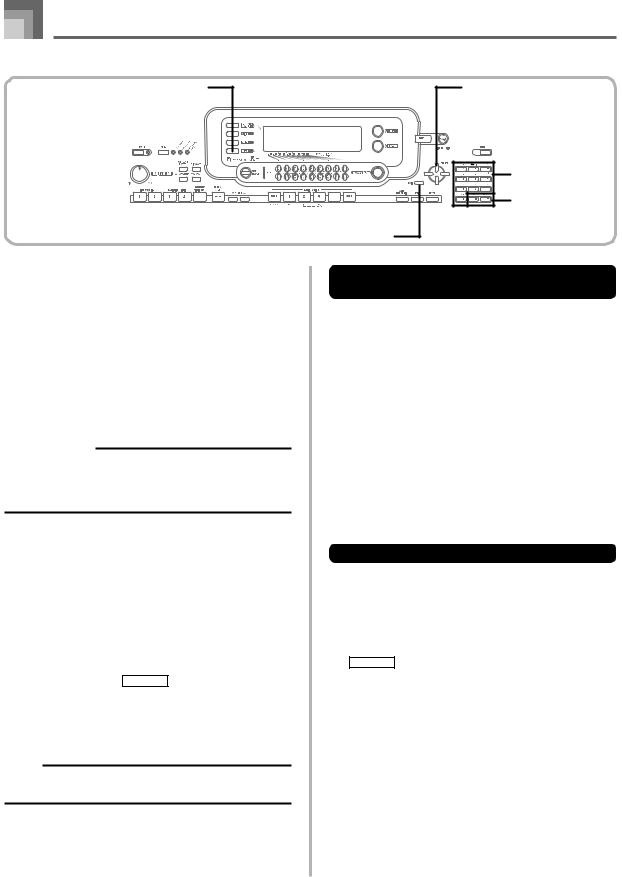
Applying Effects to Tones
EFFECT
Selecting a DSP Type
In addition to the 100 built-in effect types, you can also edit effect types to create your own and store them in user memory. You can have up to 100 effect types in user memory at one time. You can also select the DSP type of the last DSP enabled tone that you used. This means you always have access to the DSP type of Advanced Tones and tones you download over the Internet. To select the DSP type of the last DSP enabled tone that you used, select “ton” in step 3 of the procedure below.
Perform the following steps to select a DSP type.
PREPARATION
•When using a DSP effect, you should use the Mixer to confirm that the DSP lines of the required parts are turned on. See “Mixer Function” on page E-40 for more information.
1Press the EFFECT button so the EFFECT indicator appears on the display.
2Press the [ ] CURSOR button.
•The DSP type setting screen (step 3) will appear automatically about fives seconds after you press the button.
3Use the [+] and [–] buttons or number buttons to select the type of DSP you want.
•See the separate Appendix E for information about the DSP types that are available.
•Here you could also change the parameters of the effect you selected, if you want. See “Changing the Settings of DSP Parameters” for more information.
NOTE
•The DSP type display area shows the DSP number (000 to 199), or “ton” (user tone created using DSP).
CURSOR
Number buttons
[+]/[–]
EXIT
Changing the Settings of DSP
Parameters
You can control the relative strength of a DSP and how it is applied. See the following section titled “DSP Parameters” for more information.
1After selecting the DSP type you want, use the [ ] and [ ] CURSOR buttons to display the parameter
whose setting you want to change.
• This displays the parameter setting screen.
2Use the [+] and [–] buttons or the number buttons to make the parameter setting you want.
•Pressing the [+] and [–] buttons at the same time returns the parameter to its recommended setting.
3Press the EFFECT or EXIT button.
• This exits the tone or rhythm setting screen.
DSP Parameters
The following describes the parameters for each DSP.
DSP
■ Parameter 0 to 7
These parameters differ in accordance with the algorithm* of the selected DSP type. For details, see the separate Appendix E, and the “algorithmlist_e.pdf” file in the “English” folder on the CD-ROM that comes with your
keyboard.
*Effector structure and operation type
■DSP Reverb Send (Range: 000 to 127)
Specifies how much of the post-DSP sound should be sent to reverb.
■DSP Chorus Send (Range: 000 to 127)
Specifies how much of the post-DSP sound should be sent to chorus.
E-28
